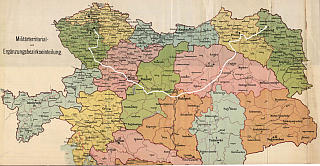
Švejk's journey on a of Austria-Hungary from 1914, showing the military districts of k.u.k. Heer. The entire plot of The Good Soldier Švejk is set on the territory of the former Dual Monarchy.
The Fateful Adventures of the Good Soldier Švejk (mostly known as The Good Soldier Švejk) by Jaroslav Hašek is a novel that contains a wealth of geographical references - either directly through the plot, in dialogues or in the author's narrative. Hašek was himself unusually well travelled and had a photographic memory of geographical (and other) details. It is evident that he put a lot of emphasis on geography: Eight of the 27 chapter headlines in the novel contain geographical names.
This web site will in due course contain a full overview of all the geographical references in the novel; from Prague in the introduction to Klimontów in the unfinished Part Four. Continents, states (also defunct), cities, market squares, city gates, regions, districts, towns, villages, mountains, mountain passes, oceans, lakes, rivers, caves, channels, islands, streets, parks and bridges are included.
The list is sorted according to the order in which the names appear in the novel. The chapter headlines are from Zenny Sadlon's recent translation (1999-2024) and will in most cases differ from Cecil Parrott's translation from 1973.
The quotes in Czech are copied from the on-line version of The Good Soldier Švejk: provided by Jaroslav Šerák and contain links to the relevant chapter. The toolbar has links for direct access to Wikipedia, Google maps, Google search, svejkmuseum.cz and the novel on-line.
The names are coloured according to their role in the novel, illustrated by these examples: Sanok a location where the plot takes place, Dubno mentioned in the narrative, Zagreb part of a dialogue, and Pakoměřice mentioned in an anecdote.
 Places index of countries, cities, villages, mountains, rivers, bridges ... (592)
Show all
Places index of countries, cities, villages, mountains, rivers, bridges ... (592)
Show all I. In the rear
I. In the rear  14. Švejk as military servant to senior lieutenant Lukáš (60)
14. Švejk as military servant to senior lieutenant Lukáš (60) II. At the front
II. At the front  2. Švejk's budějovická anabasis (64)
2. Švejk's budějovická anabasis (64) 3. Švejk's happenings in Királyhida (43)
3. Švejk's happenings in Királyhida (43) III. The famous thrashing
III. The famous thrashing  1. Across Magyaria (38)
1. Across Magyaria (38) 2. In Budapest (38)
2. In Budapest (38) 3. From Hatvan to the borders of Galicia (50)
3. From Hatvan to the borders of Galicia (50) 4. Forward March! (42)
4. Forward March! (42)



|
I. In the rear |
 | |
14. Švejk as military servant to senior lieutenant Lukáš | |||
 | Na Zderaze |  | ||||
| ||||||

Pohled do ulice Na Zderaze uprostřed s domem čp. 271 na Novém Městě na nároží s ulicí Na Zbořenci.
Na Zderaze is mentioned by Švejk in his long story about the big card-playing session. This was in connection with himself having been gambled away by Feldkurat Katz and therefore now became the servant of Oberleutnant Lukáš. The big winner in the card-playing anecdote, old tinsmith Vejvoda, lived in this street. The session took place in a pub behind Stoletá kavárna.
Na Zderaze appears again in [III.2] during a conversation between Švejk, Oberleutnant Lukáš and Offiziersdiener Baloun in Budapest. The good soldier tells a petrified Baloun that he had read in the papers that a whole family had been poisoned by liver paté there.
Background
Na Zderaze is a street in Nové město between Karlovo náměstí and Vltava. It stretches parallel to the river from Myslíkova ulice to Resslova ulice. Next to Stoletá kavárna and Na Zbořenci the street splits in two. The steet Na Zbořenci behind Stoletá kavárna was the likely location of the tavern where the famous game of cards took place.
Quote(s) from the novel
[I.14.1] Na Zderaze žil nějakej klempíř Vejvoda a ten hrával vždy mariáš jedné hospodě za ,Stoletou kavárnou’.
[I.14.1] Kominickej mistr byl už do banku dlužen přes půl druhého milionu, uhlíř ze Zderazu asi milion, domovník ze ,Stoletý kavárny’ 800.000 korun, jeden medik přes dva miliony.
[I.14.1] Zabavili bank, vedli všechny na policii. Uhlíř ze Zderazu se zprotivil, tak ho přivezli v košatince.
[III.2] Já jsem čet několikrát v novinách, že se celá rodina votrávila játrovou paštikou. Jednou na Zderaze,jednou v Berouně, jednou v Táboře, jednou v Mladé Boleslavi, jednou v Příbrami.
Literature
 | Myslíkova ulice |  | |||
| |||||
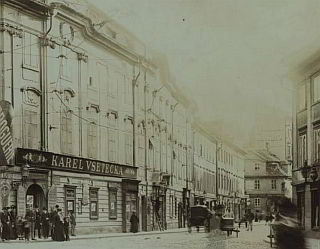

, 29.4.1909
Myslíkova ulice is mentioned in the anecdote about the great card-playing party in the pub behind Stoletá kavárna. Old tinsmith Vejvoda went to ask for help from the patrolling police in this street after winning to the extent that the other card players started to make it unpleasant for him.
Background
Myslíkova ulice is a street in Nové město that stretches from Spálená ulice down towards Vltava. One of the side streets is Na Zderaze.
Myslíkova ulice is a street Jaroslav Hašek would have known very well. Not only was it in the middle of his stomping ground in Praha II. - number 15 housed the editorial offices and print-works of Kopřivy (Nettles) and Právo lidu (The Peoples Right), publications of the Czechoslavic Social Democratic Labour Party. Hašek contributed frequently to both publications in 1913 and 1914.
Quote(s) from the novel
[I.14.1] A jen tak bez klobouku vyběh na ulici a přímo do Myslíkovy ulice pro strážníky. Našel patrolu a oznámil jí, že v tej a tej hospodě hrajou hazardní hru.
Literature
- Stehlíkův historický a orientační průvodce ulicemi hlavního města Prahy, ,1929
- Můj přítel Hanuška, Jaroslav Hašek,5.10.1913
 | Monte Carlo |  | |||
| |||||
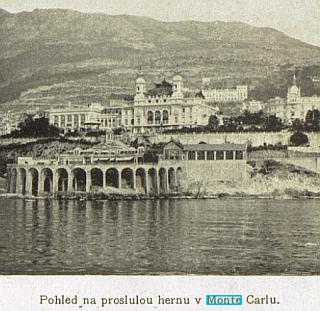
,2.12.1910
Monte Carlo is mentioned in the anecdote about the great card-playing party of old tinsmith Vejvoda. The police inspector though this was worse than Monte Carlo.
Background
Monte Carlo is the most prosperous district of the Principality of Monaco and is best known for its casino that indirectly is referred to in the novel.
The districts road to fame started in 1863 when the current casino was completed. The same year the well known financier François Blanc (1806-1877), until then director of the casino in Bad Homburg, was hired to manage the casino. It still took many years before Monte Carlo became a household name for gambling, but by the outbreak of World War I it was already famous world wide.
In the manuscript Jaroslav Hašek spelt the name Monte Karlo but during a "clean-up" of The Good Soldier Švejk in the early 1950's, this and some other "oddities" were corrected. The inter-war issues of the novel, published by Adolf Synek, kept Hašek's original spelling.
Quote(s) from the novel
[I.14.1] ,Tohle jsem ještě nežral,’ řekl policejní inspektor, když viděl takový závratný sumy, tohle je horší než Monte Karlo.
Also written:Monte KarloHašek
Literature
- Monte Carlo, ,2.4.1909
- The Magician of Monte Carlo, ,18.5.2011
 | Chodov |  | |||
| |||||

Chodov, 1908

,1.1.1914
Chodov is mentioned in a song that Feldkurat Katz' new servant sings after considerable intake of strong drinks.
Background
Chodov is the name of four places in Bohemia, one on the outskirts of Prague and the three others in the west of the country. The text in the quote is picked from five different folk songs[a]. The first line is from a song from the Chodsko region near the border with Bavaria, so here it certainly refers to Chodov by Domažlice.
In 1913 Chodov belonged to hejtmanství Domažlice and the like-named okres. The population count was 1,947 and all but one were registered with Czech as their mother tongue. The community consisted of the villages Chodov, Trhanov and Pec.
Re-used text
The song-fragment from the book had already been used by Jaroslav Hašek. On New Years Day 1914 Kopřivy printed A story about a proper man but here the author uses Domažlice instead of Chodov.
Demography
According to the 1910 census Chodov had 1,947 inhabitants of whom 1,945 (99 per cent) reported using Czech in their daily speech. The judicial district was okres Domažlice, administratively it reported to hejtmanství Domažlice.
Source:Seznam míst v království Českém(1913)
Military
Per the recruitment districts, infantrymen from Chodov were usually assigned to Infanterieregiment Nr. 35 (Pilsen) or k.k. Landwehrinfanterieregiment Nr. 7 (Pilsen).
Quote(s) from the novel
[I.14.1] Švejk s novým mužem strávili noc příjemně vařením grogu. K ránu stál tlustý infanterista sotva na nohou a pobručoval si jen podivnou směs z různých národních písní, která se mu spletla dohromady:
Okolo Chodova teče vodička, šenkuje tam má milá pivečko červený. Horo, horo, vysoká jsi, šly panenky silnicí, na Bílé hoře sedláček oře.
Credit: Jaroslav Šerák
Also written:Meigelshofde
Literature
- Povídka o pořádnem člověku, Jaroslav Hašek,1.1.1914
- Historie obce Chodov, ,2017
- Okolo Chodova - směs českých lidových, [a]
| a | Okolo Chodova - směs českých lidových |
 | Bílá Hora |  | |||
| |||||

Světozor, , 7.11.1913
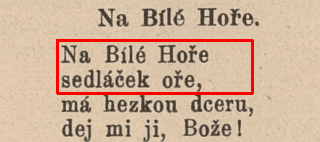
Sokolský zpěvník, 1909

Bílá Hora is mention in the song Feldkurat Katz's new putzfleck sings after consuming solid quantities of strong drink.
Background
Bílá Hora (The White Mountain) is a hill on the western outskirts of Prague, between Smíchov, Břevnov and Ruzyně. Until 1922 it belonged to the village Řepy in hejtmanství and okres Smíchov, and in the ninteen-sixties it became part of the captial.
It is primarily known for the battle on 8 November 1620 that effectively ended Czech independence. Habsburg rule followed and lasted until 1918. The battle is regarded as one of the most important events of the Thirty Year War (1618-1648).
The text in the quote is picked from five different folk songs, also pointed out by the author himself. The line featured here is from the well known folk song "Na Bílé Hoře" (At White Mountain)[a]. See also Chodov.
Military
Per the recruitment districts, infantrymen from Bílá Hora were usually assigned to Infanterieregiment Nr. 28 (Prag) or k.k. Landwehrinfanterieregiment Nr. 8 (Prag).
Quote(s) from the novel
[I.14.1] Švejk s novým mužem strávili noc příjemně vařením grogu. K ránu stál tlustý infanterista sotva na nohou a pobručoval si jen podivnou směs z různých národních písní, která se mu spletla dohromady:
Okolo Chodova teče vodička, šenkuje tam má milá pivečko červený. Horo, horo, vysoká jsi, šly panenky silnicí, na Bílé hoře sedláček oře.
[II.3] My si sedneme naproti nim, jen jsme si überšvunky položili před sebe na stůl, a povídáme si: ,Vy pacholci, my vám dáme láňok,’ a nějakej Mejstřík, kerej měl ploutev jako Bílá hora, se hned nabíd, že si půjde zatančit a že nějakýmu syčákovi vezme holku z kola.
Credit: Jaroslav Šerák
Also written:The White MountainenDer Weiß BergdeDet kvite bergno
Literature
- Okolo Chodova - směs českých lidových, [a]
- Na Bílé Hoře,
- Bílá Hora a násilná protireformace katolická,
| a | Okolo Chodova - směs českých lidových |
 | Toledo |  | |||
| |||||

Toledo en las fotos de Thomas (1884, 1910)

Světozor, , 13.1.1911
Toledo is mentioned as the Hertugen av duque Almavira is supposed to have eaten his servant Fernando during the siege of the city. In Budapest, Einjährigfreiwilliger Marek makes a similar reference, but the siege is now of Madrid and the Napoleonic wars are mentioned explicitly.
Background
Toledo is a historic city in Spain, 70 km south of Madrid. In 1986 the city was entered as a UNESCO World Heritage site. The city prospered in medieval times, and was for a while capital of Castilla. Today the city is capital of the Castilla-La Mancha region and a major tourist attraction.
The historical event in question could be from 930 to 932 when the city was encircled by the Moors during a Christian uprising. After a two year siege it surrendered due to hunger. A shorter siege took place in 1085 when the city was wrestled away from the Moors by Christians.
Jesús Carrobles Santos, "Historia de Toledo", 1997
Durante dos años se mantuvo el asedio a Toledo. Sus habitantes, como ya habían hecho en otras ocasiones, volvieron a solicitar ayuda militar cristiana, esta vez a Ramiro II. Pero el ejército que éste envió fue derrotado por las tropas omeyas. Aislados del exterior y acosados por el hambre, los toledanos tuvieron que rendirse. De esta manera, el 2 de agosto del 932, Abd al-Rahmán III entró a caballo en la ciudad donde estableció una numerosa guarnición, aunque no adoptó represalias ni medidas de castigo.
Quote(s) from the novel
[I.14.2] Našli bychom tam, že vévoda z Almaviru snědl svého vojenského sluhu při obležení Toleda z hladu bez soli..
Literature
 | Swabia |  | |||
| |||||
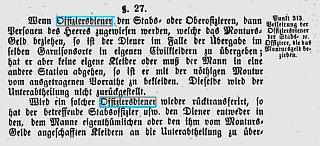
Leitfaden zur Manipulation bei den Unter-Abtheilungen der k.k. Landarmee, 1876
Swabia is indirectly mentioned by the author in the chapter about officer's servants. He mentions an old Swabian book about the art of warfare where it is described which personal traits an officer's servant is required to posses. It is not a small deal, he has to be a model human being.
Background
Swabia is a historical region in southern Germany that spans the borders of the current states Bavaria and Baden-Württemberg. The principal cities in the area are Stuttgart, Ulm and Augsburg.
Type fonts
The author refers to an old Swabian book on the art of warfare, but it is not known what book he refers to. In Czech the expression švabach (Swabian writing) is often (imprecisely) used as a term for the old German type fonts (Frakturschrift) so the book is not necessarily of Swabian origin at all. At the author's time nearly all German-language newspaper and books used "Fraktur" fonts so he could in principle have referred to any old book in German about the art of waging war. The English translator of The Good Soldier Švejk, Cecil Parrott, evidently assumes this when he translates the phrase to "an old German book".
Jaroslav Hašek visited Swabia in 1904 and eventually wrote a few humorous stories from his travels here. Sjå Bavaria.
Quote(s) from the novel
[I.14.2] Ve staré švábské knize o umění vojenském nalézáme též pokyny pro vojenské sluhy. Pucflek staré doby měl býti zbožný, ctnostný, pravdomluvný, skromný, statečný, odvážný, poctivý, pracovitý. Zkrátka měl to být vzor člověka.
Also written:Švábskocz
Literature
- Přátelský zápas mezi Tillingen a Höchstädt, Jaroslav Hašek,10.7.1921
 | Graz |  | |||
| |||||

Graz. Hauptplatz. Um 1910.
© IMAGNO/Austrian Archives
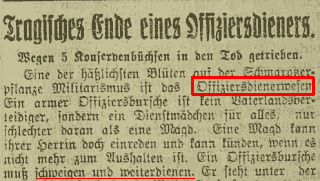
, 10.6.1912
Graz is mentioned by the author in the chapter about officer's servants. Here he recounts a trial in Graz in 1912 against a captain who had kicked his servant to death and had escaped without punishment "because it was only the second time he did it".
Graz is mentioned late in the novel in connection with Ratskeller.
Background
Graz is the second largest city on Austria and the capital of Styria. The city has appx. 250,000 inhabitants (2006). In 1910 the population counted almost 200,000.
Garrison city
Graz hosted the headquarters of 3. Armeekorps that recruited from Styria, all of current Slovenia and from smaller areas that is currently on Italian and Croat territory (Trieste og Istria). The recruitment districts with correspondingly numbered infantry regiments, were: 27 (Graz), 7 (Klagenfurt), 47 (Maribor), 17 (Ljubljana), 87 (Celje) and 97 (Trieste).
Officer's servants
It has not been possible to find a direct parallel to the case from 1912 about the captain who allegedly kicked his servant to death and was acquitted. Most probably the story is a product of the author's imagination and his tendency to grotesque exaggerations. That said the newspaper that year wrote about several other incidents where officer's servants were involved. There are reports about servants who stole from their officers, servants who committed suicide, and one servant who failed in an attempt to kill his superior and thereafter failed in killing himself.
An article in the Graz newspaper Arbeiterwille from 1912 deals with a case where an officer's servant commits suicide after being harassed over time and finally unjustly accused of having stolen five tins of conserves. The article also puts the tragedy in a greater perspective. It deals in more general terms with the hopeless situation of the army servant. He was obliged to serve not only his superior officer but also the family. If the situation became unbearable he couldn't simply quit his post as his civilian colleague could. The article advocates scrapping the whole institution of officer's servants, and moreover has certain parallels to the author's own description of the status of the officer's servant.
Concentration camp
During World War I Thalerhof by Graz was the site of the only concentration camp in the Austrian part of the Dual Empire (there were two in Hungary). See Steinhof.
Demography
According to the 1910 census Graz had 151 781 inhabitants.
Military
Per the recruitment districts, infantrymen from Graz were usually assigned to Infanterieregiment Nr. 27 (Graz) or k.k. Landwehrinfanterieregiment Nr. 3 (Graz).
Quote(s) from the novel
[I.14.2] Roku 1912 byl ve Štyrském Hradci proces, při kterém vynikající úlohu hrál jeden hejtman, který ukopal svého pucfleka.
[IV.1] Všechny lidi, který potkával na ulici, viděl buď na nádraží v Miláně, nebo s nimi seděl ve Štýrským Hradci v radničním sklepě při víně.
Also written:Štýrský Hradeccz
Literature
- Revolveratentat eines Offiziersburschen genen einen Hauptmann, ,1.4.1912
- Diebstahl und Desertion, ,21.5.1912
- Tragisches Ende eines Offiziersdieners, ,10.6.1912
 | Dubno |  | ||||
| ||||||
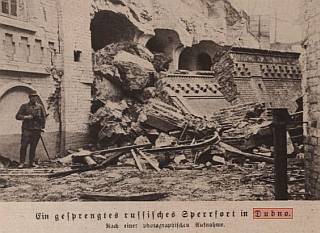
,13.4.1916
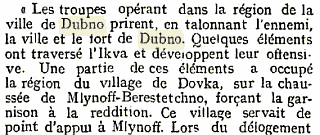
,12.6.1916
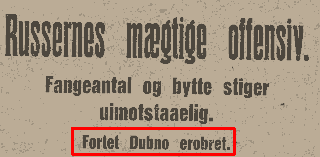
,13.6.1916
Dubno is mentioned when the author describes an officer's servant who was captured by the Russians. He dragged enormous amounts of luggage Dubno to Darnytsa and on to Tashkent where he pegged out from typhus on the top of the heap.
In the same section Hašek mentions "storming" Dubno which presumably refers to the events on 8 September 1915.
Background
Dubno (ukr. Дубно, rus. Дубно) is a city in the Volhynia province of Ukraine, until 1917 part of the Russian Volhynia governate. The city is located 15 km south of Chorupan where Jaroslav Hašek was captured on 24 September 1915. The area by Dubno had at the time a considerable number of Czech immigrants. See Zdolbunov.
Dubno was strategically important due to its fortress and the railway connections to the north and south. Austro-Hungarian forces entered the city on 8 September 1915 after an unexpected Russian withdrawal[a]. The latter re-conquered Dubno on 10 June 1916 during the Brusilov offensive[b].
Dubious claim
The city's web page claims that Jaroslav Hašek visited in 1915[c]. This seems improbable as Dubno was on Austrian hands at the time when the author was in the area. It is much more likely that he visited in 1916 and 1917 when the city was back in Russian hands and the author travelled in the aera, both as a reporter and from May 1917 as an ordinary soldier.
Österreich-Ungarns letzter Krieg, Band III
Schon am Vormittag 8.9.1915 langte beim 4. Armeekmdo. die überraschende Nachricht ein, daß Dubno vom Feinde preisgegeben sei und die Ikwabrücken bei der Stadt in Flammen stünden.
Quote(s) from the novel
[I.14.2] Viděl jsem jednoho zajatého důstojnického sluhu, který od Dubna šel s druhými pěšky až do Dárnice za Kyjevem.
[I.14.2] Dnes jsou důstojničtí sluhové roztroušení po celé naší republice a vypravují o svých hrdinných skutcích. Oni šturmovali Sokal, Dubno, Niš, Piavu.
Credit: Österreich-Ungarns letzter Krieg
Also written:ДубноruДубноua
Literature
- Історія міста, [c]
- Дубно,
- Ze životě našich krajanů v cízíně, ,5.3.1914
- Die Festung Dubno genommen, ,9.9.1915 [a]
- Från östra krigsskådeplatsen, ,13.6.1916 [b]
- U Dubna 1915, V. Mišner
| a | Die Festung Dubno genommen | 9.9.1915 | |
| b | Från östra krigsskådeplatsen | 13.6.1916 | |
| c | Історія міста |
 | Darnytsa |  | ||||
| ||||||
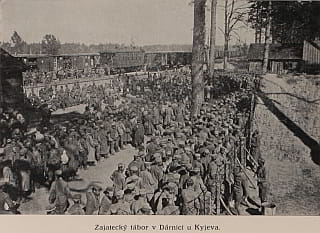
,1925
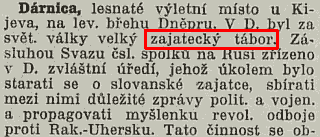
,1930

Elsa Brändström
,31.7.1932
Darnytsa is mentioned in connection with the officers servant who dragged his luggage from Dubno to Tashkent and in the end perished from typhus on top of the entire heap.
Background
Darnytsa (ukr. Дарниця) is today a district of Kyiv, east of the river Dniepr. Nowadays Darnytsa is a huge suburb, dominated by high-rise apartment blocks. There is a street named after Jaroslav Hašek here.
Darnytsa was a well-known transit camp that existed from 1915. In the beginning the camp was very primitive and lacked the most basic facilities. Diseases raged and mortality rates were scaringly high. The camp was also pivotal in supplying the Czech anti-Austrian volunteer forces, who from 1916 were allowed to recruit in Russian prisoner of war camps. See České legie.
Hašek and Darnica
According to Jaroslav Kejla the author was interned in the transit camp here for three days in the autumn of 1915, probably in early October[a]. From here he was sent onwards to Totskoye in southern Ural. His prisoner card has him registered in Penza on 6 October 1915. Kejla reports that the prisoners walked the 300 km from the Dubno-region to Darnytsa on foot on foot from 24 September, but this fits badly with Penza and 6 October. An explanation may be that the date is according the old Russian calendar, in which case the registration in Penza happened on 19 October.
There is also little doubt that Hašek revisited Darnytsa as a recruiter and agitator after he joined České legie in Kiev in July 1916.
Quote(s) from the novel
[I.14.2] Viděl jsem jednoho zajatého důstojnického sluhu, který od Dubna šel s druhými pěšky až do Dárnice za Kyjevem.
Credit: Jaroslav Kejla, Elsa Brändström
Also written:DárniceczDarnitsannДарницаruДарницяua
Literature
- Jak to bylo v bitvě u Chorupan kde se dal Jaroslav Hašek zajmout, ,1972 [a]
- Dárnica,
- Jak prý se vedlo Němcům v "českém zajetí" ..., ,10.5.1918
- Die tschecho-slawische Armee, ,20.9.1918
- Darnica - Kijev, ,1.9.1926
- Unter Kriegsgefangenen in Russland und Sibirien, Elsa Brandström,31.7.1932
- V Dárnici,
| a | Jak to bylo v bitvě u Chorupan kde se dal Jaroslav Hašek zajmout | 1972 |
 | Kiev |  | ||||
| ||||||

Saint Sophia square
,1925

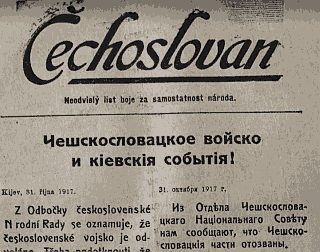
,31.10.1917
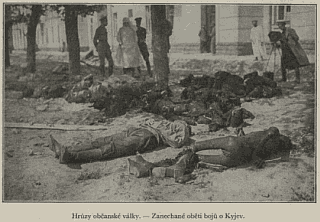
Horrors of the civil war - abandoned corpses after the fighting in Kiev (1918)
,1926
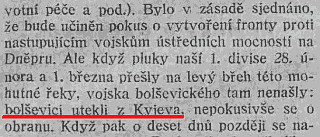
,23.3.1928
Kiev is mentioned 9 times in The Good Soldier Švejk.
Kiev is first mentioned when the author describes an officer's servant who was captured by the Russians. He dragged enormous amounts of luggage from Dubno to Darnytsa beyond Kiev and on to Tashkent where he pegged out from typhus on the top of the heap.
Soon after the city reappears when Švejk reads in a newspaper that "the commander of Przemyśl, general General Kusmanek, has arrived in Kiev".
During Švejk's stay in Przemyśl and his interrogation there, Kiev is mentioned no less than 7 times. Most of this occurs when a Polish informer-provoker is sent into Švejk's cell and tries to construct an incriminating story: that the two had met in Kiev.
Background
Kiev (ukr. Київ, rus. Киев) is the capital and largest city of Ukraine. It straddles both banks of the river Dnieper and has nearly 3 million inhabitants, making it the 7th largest city in Europe. The administrative centre and historic districts are located on the hills on the west bank.
Kiev was in 1914 capital of the Russian Kiev military district and "gubernia" of the same name. It had been under Russian control from the 17th century, although with a noticeable Polish footprint. The city also counted a large number of Jews.
The city and the province had a sizeable Czech immigrant community and a Czech weekly Čechoslovan was published in Kiev until February 1918. During World War I the city was, together with Paris and Petrograd, the main centre of the Czechoslovak independence movement.
Turbulent times
Until the Russian October Revolution Kiev was relatively unaffected by the war apart from the general shortages and the fact that the city was the centre of the military assembly area and an important military-administrative centre. Kiev was also the headquarters of the Russian branch of the Czechoslovak National Council (see České legie). The leader of the Czechoslovak independence movement, professor Professor Masaryk, stayed here for long periods between May 1917 and February 1918. It was in Kiev that he on 7 February 1918 signed the treaty of the transfer of the Legions from the Russian to the French army.
The Bolshevik coup in Petrograd on 7 November 1917 had far-reaching consequences for Kiev. Early in 1918 the Bolsheviks initiated military operations to gain control of Ukrainian territory, which at the time was partly controlled by the Tsentralna Rada (Central Council) of the Ukrainian National Republic. Red Guards led by Vladimir Antonov-Ovseyenko invaded the areas east of Dnieper, on 28 January they reached Kiev, and on 8 February 1918 the battle for the city was over.
The forces that entered Kiev were commanded by Mikhail A. Muravyov, a former officer in the Russian imperial army who was pivotal in defeating the forces of Kerensky who attempted to regain control of Petrograd during the October Revolution. He now acted as chief of staff for Antonov-Ovseyenko. He was a capable but brutal and megalomaniac officer. His deputy commander was Václav Fridrich, a former Czech legionnaire who had been expelled from the Legions for disciplinary reasons, and now as was imprisoned in Darnytsa, but set free by Muravyov's advancing troops. During the 10 day long siege of Kiev and ensuing occupation, a wave of terror, looting and killing followed. Muravyov later said that poison gas was used. Officers, members of the bourgeois and random inhabitants were slaughtered in their thousands. Muravyov and the atrocities of his troops became a liability for the Bolsheviks and he was transferred to the front against Romania on 28 February.
At the same time (9 February) Ukraine signed a peace treaty with the Central Powers. Professor Professor Masaryk who was staying in Kiev during this period, experienced the terror, but personally he got on well with Muravyov. With representatives for the Entente present, Masaryk and Muravyov reached an agreement that permitted the Legions to leave Ukraina unhindered and also to keep their weapons. According to Masaryk the deal was signed on 16 February.
The red reign of terror in Kiev didn't last long. On 18 February 1918 the Central Powers invaded Ukraine and already on 1 March German troops reached Kiev. The Red Guards and the Legions fled the city, and amongst those who escaped was Jaroslav Hašek.
Hašek in Kiev

Hotel Praha hosted the editorial offices of Čechoslovan
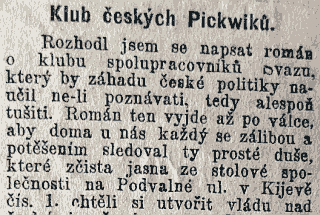
,23.4.1917
Thus Jaroslav Hašek witnessed those dramatic events in Kiev in February 1918. He had stayed for long periods in the city from 28 June 1916 [a] to May 1917 and again from 15 November until the end of February 1918. He was co-editor of Čechoslovan and also had duties involving recruitment and propaganda in prisoners camps. It was in Česchoslovan he wrote Povídka o obrázu císaře Františka Josefa I (The story of the picture of Emperor FJI) who led to a process "in absentia" of high treason back in Austria. Early in 1917 he published the second version of the "Soldier Švejk", Dobrý voják Švejk v zajetí.
His time in Kiev was ridden with controversies: he was involved in a row with a Russian officer who he insulted and as a result ended up in prison. Soon after (early 1917) he was "deported" to the front and as a goodbye he published Klub českých Pickwiků (The Czech Pickwick Club) where he ridiculed some of the leaders of the Czechoslovak independence movement in Russia. From his "exile" at the front he was eventually forced to apologise in writing.
Hašek was recalled to Kiev on 15 November 1917 in order to testify against the alleged Austrian spy Alexander O. Mašek who he had earlier helped uncover. It was also in Kiev, during the first two months of 1918, that Jaroslav Hašek changed from being openly critical towards the Bolsheviks to openly sympathise with the new rulers in Petrograd. The reason for this turnaround are probably mixed but there is reason to believe that the young Communist Břetislav Hůla during this period had considerable influence on Hašek's political views. The two were both editors at Čechoslovan and travelled together to Moscow after their escape from Kiev. According to Václav Menger they were at the time very close (Václav Menger used the expression "inseparable").
Important in understanding this shift is also that Hašek was firmly against transferring the Legions to France, and that they pulled out of Ukraine rather than fighting the Germans who were approaching Kiev. In a public meeting on 24 February he voiced his objections. He stated his point of view in detail in an article in Průkopník in Moscow on 27 March 1918. From Znal jsem Haška, Josef Pospíšil Proclamation from Václav Fridrich, Muravyov's chief of staff. ,12.2.1918.
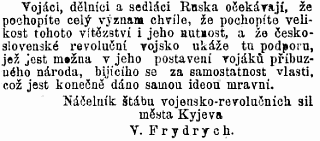
Josef Pospíšil relates that Hašek met the leadership of the Bolshevik occupiers of Kiev in February. He was on friendly terms with them and recognised them as very capable people. That this positive personal impression may also have contributed to the author's radicalisation. Who these leaders were is not mentioned but it must be assumed that he met Fridrich (who he surely knew) and probably also Muravyov.
The occupants also took measures that Hašek probably approved of: price control (bread became cheaper), limit on bank transactions, nationalisation of the finance sector and a one time tax on rich citizens (contribution). Ironically enough the Bolsheviks also abolished capital punishment. In general the Czechoslovaks were on good terms with the revolutionary authorities. This was during February 1918 repeatedly stated by Československý deník, the official paper of the Czechoslovak National Council in Russia.
On the wall of the former Hotel Praha, the building that hosted the editorial offices of the paper, a memorial plaque honouring the author still hangs (2010).
General Kusmanek in Kiev
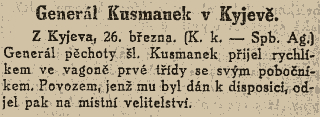
,28.3.1915
Finally back to the quote by Švejk about general General Kusmanek in Kiev. It is authentic and copied word by word from the press. This brief quote appeared in Národní politika 4 April 1915 and was also printed elsewhere. Newspapers also provided more comprehensive information. Kusmanek arrived in Kiev on an express train, first class, on 25 March. This was only three days after the capitulation of Przemyśl. He was very well treated in Kiev and even stayed as a guest of the governor. Furthermore his stay in Kiev was of a temporary nature, he was to be sent to the inner parts of Russia for permanent internment.
Quote(s) from the novel
[I.14.2] Viděl jsem jednoho zajatého důstojnického sluhu, který od Dubna šel s druhými pěšky až do Dárnice za Kyjevem.
[I.14.4] Švejk posadil se na lavici ve vratech a vykládal, že v bitevní frontě karpatské se útoky vojska ztroskotaly, na druhé straně však že velitel Přemyšlu, generál Kusmanek, přijel do Kyjeva a že za námi zůstalo v Srbsku jedenáct opěrných bodů a že Srbové dlouho nevydrží utíkat za našimi vojáky.
[IV.1] Major Wolf v té době ještě neměl zdání o tom, co vlastně všechno chystají Rakousku přeběhlíci, kteří později, setkávajíce se v Kyjevě a jinde, na otázku: „Co tady děláš?“ odpovídali vesele: „Zradil jsem císaře pána.“
[IV.1] Přihlásím se Rusům, že půjdu na forpatrolu ... Sloužil jsem u 6. kyjevské divise.
[IV.1] Já jsem v Kyjevě znal mnoho Čechů, kteří šli s námi na frontu, když jsme přešli do ruského vojska, nemůžu si teď ale vzpomenout na jejich jména a odkuď byli, snad ty si vzpomeneš na někoho, s kým si se tam tak stýkal, rád bych věděl, kdo tam je od našeho 28. regimentu?“
[IV.1] Zůstal tam zcela klidně a blábolil dále cosi o Kyjevu, a že Švejka tam rozhodně viděl, jak mašíroval mezi ruskými vojáky.
[IV.1] „Já znám vaše všechny známé z Kyjeva,“ neúnavně pokračoval zřízenec protišpionáže, „nebyl tam s vámi takový tlustý a jeden takový hubený? Teď nevím, jak se jmenovali a od kterého byli regimentu...“
[IV.1] Při odchodu řekla stvůra hlasitě k štábnímu šikovateli, ukazujíc na Švejka: „Je to můj starý kamarád z Kyjeva.“
[IV.1] Je zde přece úplné doznání obžalovaného, že se oblékl do ruské uniformy, potom jedno důležité svědectví, kde se přiznal obžalovaný, že byl v Kyjevě.
Credit: Viktor A. Savčenko, Josef Pospíšil, Pavel Gan, Radko Pytlík, Jaroslav Křížek, Tomáš Masaryk
Also written:KyjevczKiewdeКиевruКиївua
Literature
- Toulavé house, ,1971
- Jaroslav Hašek in der Ukraine 1917-18 …,
- Český patriot,
- Upomínky na můj vojenský život, ,2020 [a]
- Кто Вы, доктор Станко? – литературная гипотеза о Ярославе Гашеке в Киеве Подробнее,
- Красная гвардия. Как большевики впервые захватили Киев …, ,13.2.2015
- Главнокомандующий Муравьев: «... Наш лозунг — быть беспощадными!», ,2000
- Покоритель Киева, ,2019
- Red Guard: How the Bolsheviks seized Kyiv for the first time …, Chad Nagle,23.5.2015
- Klub českých Pikwiků, Jaroslav Hašek,23.4.1917J
- Den første fredsslutning, ,12.2.1918
- V Kyjevě 13. února, ,14.2.1918
- Z Kyjeva, ,16.2.1918G
- Boje o Kijev, ,17.2.1918G
- Als die Bolschewiken in Kiew herrschten, ,10.3.1918
- Jaroslav Hašek v legiích a proti nim, ,1.8.1937
- Vzpominka na T. G. Masaryka, Vincenc Svoboda,1937
- Jar. Hašek a legie: od zborovské bitvy až do odchodu, ,8.8.1937
- Ohlas Ríjnové revoluce v legiích, ,23.11.1967
| a | Upomínky na můj vojenský život | 2020 |
 | Ukraine |  | |||
| |||||
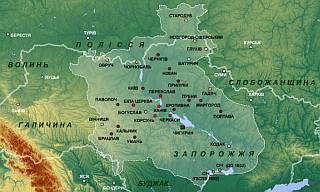
The Cossack Hetmanate, 1654
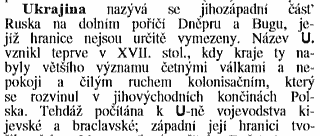
,1888-

, 1907-1913
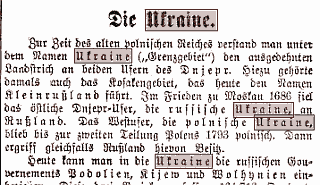
,20.8.1914

,12.12.1884
Ukraine is first mentioned when the author describes an officer's servant who was captured by the Russians. He dragged enormous amounts of luggage from Dubno to Darnytsa and on to Tashkent where he pegged out from typhus on the top of the heap.
At the very end of The Good Soldier Švejk the author touches on the relationship between Poles and Ukrainians, a conflict that had tragic consequences during World War II.
Background
Ukraine (ukr. Україна, rus. Украина) is a large and populous state in south west Europe with Kyiv as capital. The main language is Ukrainian but Russian is widely used, mainly in the east and in the south. Before World War I the name Ukraine had however a rather different meaning. According to Ottův slovník naučný (1888) it was a term that refers to "the south western part of Russia along the banks of the rivers Bug and Dnieper but which extent is not precisely defined". According to the encyclopaedia the name origins from the 17th century and means "borderland".
Meyers Konverzations-Lexikon uses approximately the same definition as Otto's Encyclopaedia but doesn't mention the river Bug; it rather states that Ukraine consists of the areas on both banks of the Dnieper. Nordic and English encyclopaedia from the time before World War I use more or less the same definition as Meyers.
The Hetmanate
The closest there was to an early Ukrainian nation state was the Hetmanate of the 17th century. It was founded through the rebellion of Bohdan Khmelnytsky against Polish supremacy, but he was dependent on help from abroad and ended up as a vassal of Moscow. The Hetmanate was historically important not only as a source of Ukrainian national identity, but it also started a process that gradually brought the Ukrainian lands under Russian control. This came at the expense of Poland and over time also the Ukrainians themselves.
The areas were thus mainly under Polish control until the 17th century, but at the peace treaty in Moscow in 1686 Poland was forced to cede the areas east of Dnieper and a smaller area around Kiev. Most of the west bank of the river only became Russian during Poland's second partition in 1793, and the rest during Poland's third partition in 1795. Galicia was ceded to Austria during Poland's first partition in 1772.
Little Russia
At the outbreak of war in 1914 Ukraine was a rather loosely defined geographical entity: it denoted the south-western part of the Tsarist empire. At the time the term Little Russia was far more commonly used, as witnessed by the entries in various encyclopaedia (amongst them Czech, Norwegian, Swedish, English and German). The term did not cover the Ukrainians part of the Dual Monarchy.
The Ukrainian language has roots at least back to the 13th century and national consciousness already existed but manifestations of nationalism were strongly suppressed by the Russian authorities. From 1804 Ukrainian was banned as a subject and as a language of teaching, a state of affairs that continued relatively unchanged until 1917. Literature and other publications written in Ukrainian were mostly published in Galicia, a region under Austrian rule. One of the victims of the Russian opression was the famous author Taras Shevchenko.
In The Good Soldier Švejk Jaroslav Hašek no doubt refers to Ukraine in accordance with the widely accepted definition of his time: as "the south-western regions of Russia".
Ruthenia
Ukrainians were recognised as a nation in Austria-Hungary and was commonly referred to as Ruthenians. In the Habsburg Empire their language and culture enjoyed far greater acceptance than in Russia. Ukrainian was one of twelve official languages and in 1918 there were 28 Ukrainian members of the lower chamber of the Austrian Reichsrat. This reflected their status as the fourth largest ethnic group in Cisleithania, behind Germans, Czechs and Poles. The Ukrainian territories of the Dual Empire extended across large parts of Galicia, eastern Slovakia, Carpathian Ruthenia and Bukovina.
The First World War
Already from the outbreak of hostilities in 1914 the war was conducted on Ukrainian soil, albeit in Galicia and Bukovina. In August 1915 the war was carried over to Russian-Ukrainian soil, and the front stretched across Russian-Ukrainian and Austrian-Ukrainian areas respectively until the summer of 1917 when the Russian army was forced out of the occupied territories once and for all.
In 1914 a considerable number of Czech immigrants lived in Ukraine, mostly in Kiev and Volhynia. It was in these circles that the seeds of what was to become České legie took root, and until March 1918 the Legions operated from Ukrainian soil.
Distrusted on both sides
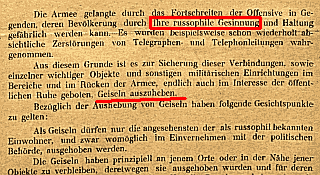
Directive on taking hostages in Galicia
© ÖStA
Ukrainians were often distrusted by both parts in the conflict and not without reason. In Galicia and other Ukrainian areas of the Dual Monarchy there was widespread sympathy for Russia, a theme Hašek also mentions in the novel. Ukrainians together with Czechs were regarded the least trustworthy nation in Austria-Hungary, and already in 1914 there were built concentration camps for civilians where "Ruthenians" made up a large portion of the inmates. This was particularly the case in Thalerhof by Graz (see Steinhof). Many Ukrainian were summarily executed as "spies" and "collaborators" in the areas near the front.
It is documented that k.u.k. Heer took prominent "Russophile" citizens hostage when Galicia was reconquered in 1915, and threatened them with execution if sabotage took place in their area. In documents related to the 2nd Army this is clearly revealed, and on regimental level even our acquaintance Čeněk Sagner recommended in writing that suspect civilians be shown no mercy.
The conditions for Ukrainians in Russia during the war was probably not much better, but the information available is not that comprehensive. The pressure on Ukrainian language and culture had been somewhat eased from 1905, but was now intensified again. The well known nurse Elsa Brändström (aka. "the Siberian angel") wrote that "millions of Poles and Ukrainians were deported" and added that Jews were particularly targeted.
Revolution
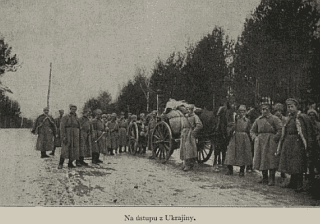
The Chechoslovak army corps (Legions) pulling out of Ukraine in March 1918
In the aftermath of the October Revolution, Ukraine declared independence and took part in the peace negotiations in Brest-Litovsk. On 9 February 1918 the treaty with the Central Powers was signed, but Kiev had already the previous day been occupied by Communist Red Guards commanded by colonel Mikhail Muravyov and a wave of terror ensued. These were events that Jaroslav Hašek personally witnessed.
On 18 February German forces invaded the now largely Bolshevik occupied Ukraine to force the revolutionary government in Russia to accept the peace terms. By the end of March all of Ukraine had been occupied, but the state formally continued to exists but now as a German puppet.
As a result of the post-World War I settlements the Ukrainian lands were split between the Soviet Union (where it was recognised as a political entity in the form of the Ukrainian Socialist Soviet Republic), Poland, Czechoslovakia and Romania.
Hašek in Ukraine

The only known photo of Jaroslav Hašek from the Russian part of Ukraine. Here with Jan Šípek and Václav Menger. Berezne, 29 September 1917 (12 October).
From July to September 1915 Jaroslav Hašek stayed on the territory of current Ukraine, as an Austrian soldier in Galicia and Volhynia. It was by Chorupan in Volhynia that the author was captured on 24 September 1915. From here the prisoners had to walk to the transit camp at Darnytsa (appx. 300 km) before they were transported onwards to camps in other parts of the Russian empire.
After having been released from the prisoner's camp in Totskoye in southern Ural, Hašek stayed in Ukraine from 28 June 1916 [a] until March 1918. During this time he worked for Czech organisations who were opposed to Austria-Hungary, units that were later to become known as Czechoslovak Legions (see České legie). He was predominately based in Kiev where he worked as an editor of Čechoslovan, but also travelled extensively between Kiev and the front. On 2 July 1917 he took part in the battle of Zborów where Czechs units for the first time fought against k.u.k. Heer.
Encyclopædia Britannica, 1911
UKRAINE (“frontier”), the name formerly given to a district of European Russia, now comprising the governments of Kharkov, Kiev, Podolia and Poltava. The portion east of the Dnieper became Russian in 1686 and the portion west of that river in 1793.
Quote(s) from the novel
[I.14.2] Nikdy nezapomenu toho člověka, který se tak mořil s tím přes celou Ukrajinu. Byl to živý špeditérský vůz a nemohu si vysvětlit, jak to mohl unést a táhnout kolik set kilometrů a potom jeti s tím až do Taškentu, opatrovat to a umřít na svých zavazadlech na skvrnitý tyf v zajateckém táboře.
Also written:UkrajinaczUkrainedeУкраинаruУкраїнаua
Literature
- Ukraine, ,1911
- Ukraine, ,1911
- Left-Bank Ukraine,
- Right-Bank Ukraine,
- History of Ukraine,
- Jaroslav Hašek in der Ukraine 1917-18 …,
- The Internment of Russophiles in Austria-Hungary, Serhiy Choliy,17.11.2020
- Ukraine, Liubov Zhvanko,8.10.2014
- Taras Hryhorovych Ševčenko, ,12.12.1884
- Den første fredsslutning, ,12.2.1918
- Boje o Kijev, ,17.2.1918J
- Upomínky na můj vojenský život, ,2020 [a]
- Ukrajina a ukrajinci, Dr. V. Charvát,1927
- Ukrajinci a jejich osvobozenecké hnutí, ,1928
| a | Upomínky na můj vojenský život | 2020 |
 | Tashkent |  | |||
| |||||
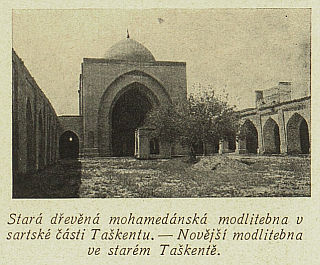
,14.3.1917

From a Red Cross report, 1916.
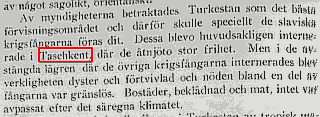
Elsa Brändström: Amongst prisonsers of war in Russia and Siberia (1921)
Tashkent is mentioned in the story the author tells about the officer's servant dragged a huge amount of luggage with him from Dubno, but who pegged out on top of his luggage in a prisoner's camp in Tashkent. He died from spotted typhus, a disease Jaroslav Hašek himself contracted in Russian captivity (but was somewhat luckier).
The city is mentioned amongst a number of places that don't at the time play a part in the plot, but that might have appeared again if Jaroslav Hašek had managed to complete the novel. See Sokal.
Background
Tashkent (rus. Ташкент) was in 1915 capital of the Russian general governorate Turkestan. It is now the capital of Uzbekistan after having been part of the Soviet Union until 1991. Today the city has more than 2 million inhabitants.
During the war there was a prisoner's camp in the city, and another one at Troytsky 30 kilometres from the centre. In both camps the inmates were mainly prisoners from the Slav nations of Austria-Hungary. Because many Czech were interned here Jaroslav Hašek surely knew a few people who had stories to tell from Tashkent.
Typhus
Typhus was a big problem in all the camps in Turkestan and in 1915 and 1916 epidemics raged. Health workers were inoculated but the prisoners rarely had this privilege. The casualties reached tens of thousands. Because many Czech were interned here Jaroslav Hašek surely knew a few people who had stories to tell from Tashkent.
In 1915 the Troytsky camp was ravaged by a severe epidemic, one of the worst that hit any of the Russian prisoners camps during the war. During three month 9,000 out of 17,000 prisoners perished. Otherwise the camp in the city was regarded as a good one, and the inmates enjoyed a large degree of freedom. Officers were allowed to leave the camp without an escort.
Quote(s) from the novel
[I.14] Nikdy nezapomenu toho člověka, který se tak mořil s tím přes celou Ukrajinu<. Byl to živý špeditérský vůz a nemohu si vysvětlit, jak to mohl unést a táhnout kolik set kilometrů a potom jeti s tím až do Taškentu, opatrovat to a umřít na svých zavazadlech na skvrnitý tyf v zajateckém táboře.
Credit: Elsa Brändström, F. Thormeyer, F. Ferrière
Also written:TaškentczTaschkentdeТашкентruToshkentuz
Literature
- Tyfové serum do turkestanských táborů zajatců, ,1.4.1916
- In die Gefangenschaft, ,23.4.1916
- První noc sederová, ,14.4.1933
- Documents guerre européenne, ,1916
 | Sokal |  | ||||
| ||||||
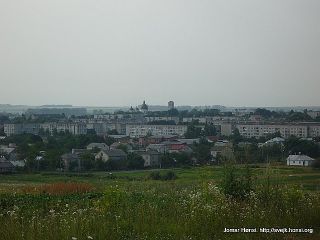
View of the city from Sokal hora, 2010.
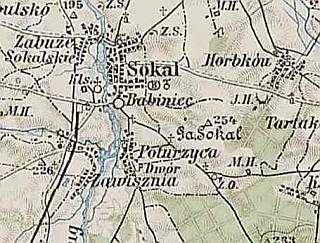
Sokal and Poturzyca on a k.u.k. military survey map.
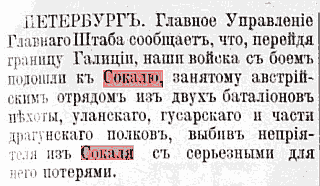
,13.8.1914
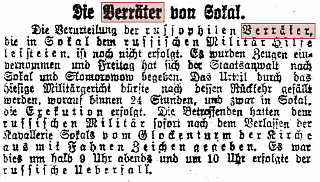
,20.8.1914
Sokal is mentioned 12 times in The Good Soldier Švejk.
Sokal (ukr. Сока́ль) is first mentioned by the author in a passage where he ironically describes how the officer servants ("Putzflecks") brag about their endeavours in various battles during the world war.
Sokal is one of a few places that appears in the chapter headers, here in [II.5]. In the content of the chapter Sokal is further mentioned by Oberst Schröder as he is about to show his fellow officers where the town is located on the map. In the end he sticks his finger in a turd that a tom-cat has been audacious enough to leave behind on the staff map.
In the next chapter [III.1] Sokal is mentioned again when Hauptmann Ságner receives an order by telegram at the station in Győr, "about quickly getting ready and set off for Sokal". The dispatcher is General Ritter von Herbert who has turned insane. At the station in Budapest [III.2] the battalion receives yet another nonsensical telegram from Herbert.
From Sanok [III.4] and until the end of the novel Sokal appears regularly, last in a conversation between Švejk and Einjährigfreiwilliger Marek where it transpires that "we are going Sokal". Marek tells Švejk that he is not going to get paid until after Sokal. Marek emphasised that it would be a useless undertaking to pay salaries to soldiers who are going to die anyway.
Beyond dispute is the fact that the author intended to place the plot at Sokal in the Part Four, a part that he never completed due to his premature death.
Background
Sokal is a regional capital in the Lviv oblast in western Ukraine. It is situated 80 km north of Lviv on the eastern bank of the Buh (Bug) and at present (2018) it has approximately 25,000 inhabitants.
From 1772 to 1918 the town belonged to Austria, in the inter-war period to Poland, after the Second World War to the Soviet Union and from 1991 to Ukraine. In 1881 the population was around 8,000 with a near equal distributions between Jews, Poles and Ukrainians. The town was situated approx. 10 km from the border with Russia.
Russian occupation
Sokal was soon after the outbreak of war attacked by Russian forces. Already 13 August 1914 the Russian general staff reported that the town had been captured, two bridges across the Bug blown up, provisions destroyed and the railway station torched. This news was however refuted by Austrian sources a few days later. These claim that the attack was a plundering mission and that the enemy had been repelled. Both Russian and Austrian reports confirm that the attack took place on 11 August, but the occupation was short-lived.
The Russians were however soon back. On 21 august the Austrians repelled another attack, but on 31 August Finnish newspapers reported that Sokal and several other towns and cities in Galicia had been captured.
In the aftermaths of the first Russian attack on Sokal, reports of treason against Austria-Hungary appeared in the newspapers. Some of the Emperor's Ruthenian (Ukrainian) subjects, 28 of them, were judged guilty as they allegedly had guided the Russians towards Sokal by signalling from church towers. They were from Skomorochy (ukr. Скоморохи) north of Sokal, and were sentenced to death on 20 August, and hanged in their home village the next day.
The Central Powers returning
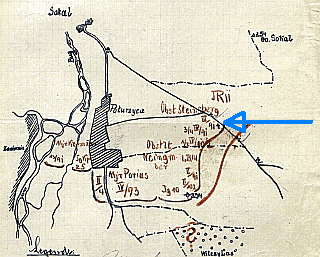
The situation south of Sokal on 27 July 1915. The blue arrow indicates the position of IR. 91, 11th field company.
© ÖStA

,29.7.1915
Sokal was reconquered by the Central Powers on 18 July 1915. For the remainder of the war the town was in Austrian hands and after the battle south of town during the next two weeks, Sokal disappears entirely from the news headlines.
The decisive battle over the control of Sokal took place from 15 to 31 July 1915. It started with an attack by k.u.k. 1. Armee, eventually supported by the German 103rd Infantry Division. They crossed the Bug and after fierce fighting they captured Sokal on the 18th. Thus k.u.k. Heer had established a bridgehead east of the river.
That same day there was however issued an order that had widespread consequences. The German commander-in-chief Mackesen ordered that 103rd Infantry Division and other German troops were to be pulled out to help general Linsingen further north. This put k.u.k. 1. Armee in a difficult situation, as the Russians, commanded by the competent general Brusilov, recaptured the hills south of Sokal on the 20th. From here they could shell the town and threaten to force the enemy back across the river.
Already the same day Paul Puhallo, commander of 1st Army, realised how serious the situation was. He asked for assistance and the request was granted. k.u.k. 2. Armee released the entire 9. Infanteriedivision (that Infanterieregiment Nr. 91 belonged to). According to the original plans they were to attack across the Bug by Kamionka Strumiłowa on 21 July, but in the night between the 20th and 21st they instead had to start marching northwards to relieve the threatened bridgehead at Sokal.
The order to move the division to this section of the front was thus the direct reason why Jaroslav Hašek got to Sokal at all, and hence leading to the town being mentioned in The Good Soldier Švejk.
Infanterieregiment Nr. 91 by Sokal
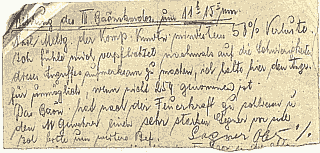
Oberleutnant Sagner reporting on the critical situation of his battalion finds itself in. The losses are reaching at least 50 per cent.
© ÖStA
The regiment reached Opulsko west of Sokal on the 22nd and the next day they were in position by Poturzyca (ukr. Поториця), a few kilometres south of the town. At 4 PM on 25 July 1915 the signal for attack on the Russian positions on the hills by Poturzyca (Kote 254, 237, 234) was given. It was a brutal battle with frightening losses on both sides. It is estimated that 9. Infanteriedivision lost around half their men; killed, wounded and missing. On both sides a large number of prisoners were taken.
In the end k.u.k. Heer had to give up the attack and pull back to positions between Sokal and Poturzyca. They were actually saved by an unexpected Russian withdrawal that was caused by a German break-through further north. Thus the Russian forces by Sokal were in danger of getting trapped and were ordered to pull back. The gymnasium where parts of IR. 91 rested from 1 to 2 August 1915 © Daniel Abraham Bojiště u Sokalu ,25.9.1924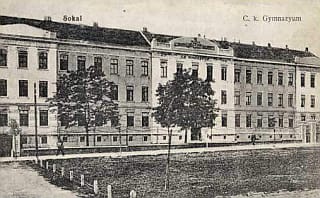

On 1 August the 9. Infanteriedivision was relieved. Parts of IR. 91 were lodged in the gymnasium in Sokal (Jan Vaněk mentions it in his diary), a fact that may have found its way into the novel but "relocated" to Sanok. In the evening of 2 August they started the march to the reserve positions by Żdżary, 15 kilometres north of Sokal. On 3 August, at 4 in the morning, the replacement had been completed. Żdżary was in an area that was infested by cholera, but it is not known whether anyone from the regiment were infected. 9. Infanteriedivision stayed in the area until 27 August when an offensive into Russia in the direction of Dubno started.
The original units from 1. Armee also took part in the battle. Amongst these were Infanterieregiment Nr. 4 (Hoch- und Deutschmeister from Vienna), Feldjägerbataillon Nr. 10 (Kopaljäger from Jihlava), Feldjägerbataillon Nr. 25 from Brno. These units had also taken part in the original conquest of Sokal, where particularly the Deutschmeister regiment distinguished itself.
Jaroslav Hašek and Sokal
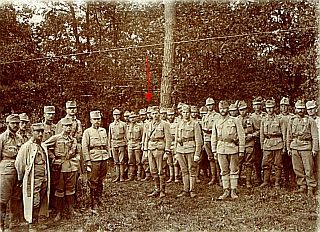
Dekorierung at IR. 91/11. field company, Żdżary, on 18.8.1915. Colonel Rudolf Kießwetter handed out medals to the soldiers. On the photo, we can apart from Kießwetter himself, identify (a.o.) Vaněk, Hašek, Lukas and Sagner. From Bestand Rudolf Kießwetter.
© ÖStA
Jaroslav Hašek served as messenger in the III. Feldbataillon, 11. Feldkompanie. The battalion held one of the most exposed positions and suffered terrible losses. Still Čeněk Sagner led his unit commendably and in battle reports he was mentioned in very favourable terms. Oberleutnant Rudolf Lukas led F11. Kompanie, one of the four companies in Sagner's battalion.
Hašek was after the battle of Sokal promoted to Gefreiter and on 18 August 1915 he was decorated with a silver medal (2nd class) for bravery demonstrated during the fighting around Poturzyca on 25 July.
Several of the "models" for characters in The Good Soldier Švejk took part in the battle for Sokal: Rudolf Lukas, Čeněk Sagner, Hans Bigler, Jan Vaněk, František Strašlipka, Jan Eybl and Franz Wenzel.
Apart from the author, Kadett Bigler and Oberleutnant Sagner were promoted after the battle. Oberleutnant Wenzel was investigated due to cowardly conduct. He allegedly left the command of his 2. battalion to Oberleutnant Peregrin Baudisch and for some mysterious reason spent time with the 4th battalion (who were reserves).
These were decorated after the battle: Jaroslav Hašek, Hans Bigler, Jan Vaněk, František Strašlipka and Čeněk Sagner. The latter was one of only three in the whole regiment who were given the highest recognition: the German "Eiserne Kreuz" (Iron Cross).
A well documented battle

From Jan Vaněk's diary. 31 July 1915.
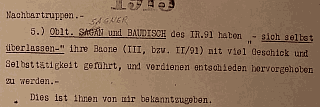
From Gefechtsbericht, 9 August 1915. This report contains stinging criticism of how the main commanders of IR. 91 conducted the battle. Regimental commander Oberst Steinsberg and the commander of the 2nd battalion, Oberleutnant Wenzel, are singled out for particularly harsh criticism.
© ÖStA
Important testimonies of the battle are the diaries of Jan Vaněk and Jan Eybl, the notes of Bohumil Vlček, all from IR. 91. Moreover there is the diary of Eugen Hoeflich (better known as Moscheh Ya’akov Ben-Gavriêl) from Feldjägerbataillon Nr. 25, Brno.
Apart from these personal accounts, detailed descriptions of the battle can be found in the regimental chronicles of IR. 91, IR73 and IR102, probably also by Die Deutschmeister, Infanterieregiment Nr. 11 and others. Österreich-Ungarns letzter Krieg describes the battle thoroughly and gives insight into the decisions and considerations further up the command chain. In the war archives in Vienna and Prague there is more material that can be found; diaries, battle reports, orders, maps, photos and more. Material on IR. 91 and Sokal can be found in both archives.
Newspaper reports that mention Sokal were numerous, but on both sides the news stream was obviously filtered and censored. The respective setbacks were "wrapped in" or not mentioned at all, and own successes exaggerated. Much more informative are newspaper items from after the war, where individuals wrote about their experiences around Sokal.
The author of this web page has not found any eye-witness accounts from the Russian side, but official reports are available in Finnish newspapers (at the time Finland was a Russian Grand Duchy) and newspapers from neutral states like Norway, Sweden, Netherlands and Switzerland.
Hašek and the 300 prisoners
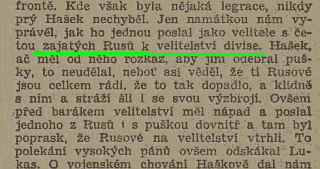
,24.2.1938
A sixteen-part series in Večerní České slovo from 1924, based partly on interviews with Rudolf Lukas, is also an important source. It has been much relied upon by post-World War II Haškologists. This despite a suspicion that the author of the series, Jan Morávek, "spiced up" his account to a considerable degree. One such case is the claim that Jaroslav Hašek was decorated because he convinced 300 Russians to give themselves up, and then led them to regiment HQ without disarming them, thus causing confusion and panic behind the lines.
This episode is not mention at all in the application for his decoration (Belohnungsantrag), but the story has many similarities with information from one of Rudolf Lukas's obituaries (Důjstonické listy, 24 February 1938). Here it transpires that Hašek actually was trusted by Lukas to lead a group of prisoners to positions behind the lines. Contrary to instructions he let them keep their weapons and this led to panic as they entered regiment HQ where the officers believed that the Russians had broken through. The episode put Lukas in a bad light but we don't know if it had any consequences for him.
Demography
According to the 1910 census Sokal had 11 610 inhabitants. The judicial district was Gerichtsbezirk Sokal, administratively it reported to Bezirkshauptmannschaft Sokal.
Military
Per the recruitment districts, infantrymen from Sokal were usually assigned to Infanterieregiment Nr. 30 (Lemberg) or k.k. Landwehrinfanterieregiment Nr. 19 (Lemberg).
Jan Vaněk
26.7.1915: Včera odpol přišel rozkaz „Ku předu“ na ruské zákopy. Nejdříve bombardovalo naše dělostřelectvo a pak jsme šli. Ale bylo to hrozné. Sotva naši lidé vyskočili na náspy, již se jich mnoho a mnoho válelo na zemi dílem mrtvých a raněných. Hrozná to byla hodinka. Postoupili jsme o 100 kroků do předu a dále to nešlo. Byli jsme seslabeni. K tomu ke všemu pršelo jen se lilo. Bláto zamazalo pušky, takže nebylo možno střílet. Trnuli jsme strachy a kdyby rusové udělali protiútok, že to nezadržíme. Ale nestalo se tak—do rána jsme se urželi a pak jsme pokračovali. Zajali jsme spousty Rusů.
Das Infanterieregiment Nr. 91 auf Vormarsch in Galizien
28. juli 1915, 11 Uhr Nachts: Gleich darauf meldte Oberleutnant Sagner: Linker Flügel des III. Bataillons hat, da das Infanterieregiment Nr. 11 zurückgeging, jeden Anschluss verloren. Gegner durchgebrochen - Pionerabteilung des Regimentsreserven eingesetzt. Bitte um 2 Kompagnien an meinen linken Flügel da dieser in äusserst kritischer Situation ist.
Quote(s) from the novel
[I.14.2] Dnes jsou důstojničtí sluhové roztroušení po celé naší republice a vypravují o svých hrdinných skutcích. Oni šturmovali Sokal, Dubno, Niš, Piavu. Každý z nich je Napoleonem: „Povídal jsem našemu obrstovi, aby telefonoval do štábu, že už to může začít.“
[II.5] "Odtud, pánové, k Sokalu na Bug," řekl plukovník Schröder věštecky a posunul ukazováček po paměti ke Karpatům, přičemž zabořil jej do jedné z těch hromádek, jak se kocour staral udělat mapu bojiště plastickou.
[III.1] Telegram zněl prosté, nešifrován: "Rasch abkochen, dann Vormarsch nach Sokal." Hejtman Ságner povážlivé zakroutil hlavou. "Poslušné hlásím," řekl Matušič, "velitel stanice dá vás prosit k rozmluvě. Je tam ještě jeden telegram." Potom byla mezi velitelem nádraží a hejtmanem Ságnerem rozmluva velice důvěrného rázu. První telegram musel být odevzdán, třebas měl obsah velice překvapující, když je batalión na stanici v Rábu: "Rychle uvařit a pak pochodem na Sokal." Adresován byl nešifrovaně na pochodový batalión 91. pluku s kopií na pochodový batalión 75. pluku, který byl ještě vzadu. Podpis byl správný: Velitel brigády Ritter von Herbert.
[III.2] Matušič přinesl na vojenském nádraží v Budapešti hejtmanovi Ságnerovi z velitelství telegram, který poslal nešťastný velitel brigády dopravený do sanatoria. Byl téhož obsahu, nešifrován, jako na poslední stanici: "Rychle uvařit menáž a pochodem na Sokal." K tomu bylo připojeno: "Vozatajstvo začíslit u východní skupiny. Výzvědná služba se zrušuje. 13. pochodový prapor staví most přes řeku Bug. Bližší v novinách."
[III.4] Ačkoliv odtud bylo spojení železniční neporušeno pod Lvov i severně na Veliké Mosty, bylo vlastně záhadou, proč štáb východního úseku udělal tyto dispozice, aby železná brigáda se svým štábem soustřeďovala pochodové prapory sto padesát kilometrů v týlu, když šla v té době fronta od Brodů na Bug a podél řeky severně k Sokalu.
[III.4] Tato nešťastná kráva, možno-li vůbec nazvati onen přírodní zjev kravou, utkvěla všem účastníkům v živé paměti, a je téměř jisto, že kdyby později před bitvou u Sokalu byli velitelé připomněli mužstvu krávu z Liskowiec, že by se byla jedenáctá kumpanie za hrozného řevu vzteku vrhla s bajonetem na nepřítele.
[IV.1] Neznalo ještě nic určitého o revolučních organizacích v cizině a teprve v srpnu na linii Sokal Milijatin - Bubnovo obdrželi velitelé bataliónů důvěrné rezerváty, že bývalý rakouský profesor Masaryk utekl za hranice, kde vede proti Rakousku propagandu. Nějaký pitomeček od divize doplnil rezervát ještě tímto rozkazem: "V případě zachycení předvésti neprodlené k štábu divize!" Toto tedy připomínám panu presidentovi, aby věděl, jaké nástrahy a léčky byly na něho kladeny mezi Sokalem- Milijatinem a Bubnovou.
[IV.3] Major otevřel si stůl, vytáhl mapu a zamyslel se nad tím, že Felštýn je 40 kilometrů jihovýchodně od Přemyšlu, takže jevila se zde hrozná záhada, jak přišel pěšák Švejk k ruské uniformě v místech vzdálených přes sto padesát kilometrů od fronty, když pozice táhnou se v linii Sokal - Turze Kozlów.
[IV.3] "U nás ho teď nedostaneš, poněvadž my jdeme na Sokal a lénunk se bude vyplácet až po bitvě, musíme šetřit. Jestli počítám, že se to tam strhne za čtrnáct dní, tak se ušetří na každým padlým vojákovi i s culágama 24 K 72 hal."
Credit: VÚA, ÖStA, Milan Hodík, Bohumil Vlček, Jan Vaněk, Jan Ev. Eybl, Eugen Hoeflich
Also written:СокальruСокальua
Literature
- Słownik geograficzny Królestwa Polskiego..., ,1880 - 1914
- Сокаль,
- Family tree ->related pages ->Sokal,
- Wir standen bei Kirchbach im I. Korps., ,1926
- Die Deutschmeister, ,1928
- Carnage by Sokal, ,2010
- Jaroslav Hašek - dobrý voják Švejk, Jan Morávek,1924
- Připomínky k románu "Dobrého vojáka Švejka", ,20.3.1956
- Pouť feldkuráta Eybla světovou vojnou,
- Válečný deník Jana Vaňka, ,2014
- Das Infanterieregiment Nr. 91 am Vormarsch in Galizien, ,1927
- Die Eroberung von Sokal durch die k.u.k. 1. Armee (15. bis 18. Juli),
- Wechselvolles Ringen um den Brückenkopf bei Sokal (20. bis 31. Juli),
- Ryssarna tränt in på österrikistk område, ,13.8.1914
- Falsche russische Siegesmeldungen, ,17.8.1914
- 22 Bauern wegen Hochverrat zum Tode verurteilt, ,19.8.1914
- Události u Sokalu, ,19.8.1914
- Der Sieg bei Sokal, ,24.8.1914
- Dopis z boje u Sokalu, ,27.8.1914
- Boje o Sokal, ,14.8.1915
- Boje o Sokal, ,4.9.1915
- Zwei Tage in der Stellung der Deutschmeister, ,11.9.1915
- Die "grünen Teufel", ,27.4.1917
- Abschied des IV. Baons vom Inf. Regimente Nr. 91., Kießwetter Oberst,3.5.1918
- Svátek mrtvých v. r. 1915, ,8.11.1930
- Zemřel kamarád, ,24.2.1938
 | Niš |  | |||
| |||||

Serbian funeral in Niš
© ÖStA

,7.11.1915
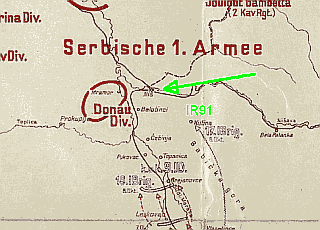
IR. 91 by Niš on 8 October 1918.
,1938
Niš is mentioned when the author riducules the officers' servants who "stormed" Niš, Sokal and Piave (and others).
Background
Niš (ser. Ниш) is a city in Serbia by the river Nišava. Counting more than 250,000 inhabitants it is the biggest city in southern Serbia and the third in the country behind Belgrade and Novi Sad.
During the war
The city was war-time capital of Serbia due to the exposed position of Belgrade at the border with Hungary. During the Central Power's offensive in the autumn of 1915 Niš was conquered by Bulgarian troops on 5 November 1915 after the Serbs had abandoned the city. It remained under Bulgarian occupation until 12 October 1918 when it was liberated by Serbian forces.
That Austrian soldiers would have been participating in the storming of Niš (as the author suggests) is unlikely as the operations against the city in 1915 were undertaken by the Bulgarian army.
IR. 91 by Niš
In late September 1918 Bulgaria pulled out of the war and left their allies on the Balkans dangerously exposed. 9. Infanteriedivision (including IR. 91) was therefore hastily transferred from the front by Piave to southern Serbia. The transport went by train via Udine, Ljubljana, Belgrade to Vranje on the Macedonian border. The division was seriously decimated and suffered from shortages and diseases. Some reserves didn't even have shoes. South of Vranje they immediately faced the advancing Serbian 1st Army and already on 3 October they had to withdraw northwards. The 17th Brigade (Infanterieregiment Nr. 91 and IR102) had a particularly arduous retreat across the mountains. On 8 October they had reached the vicinity of Niš and by 16 October had reached Vitkovač. The retreat continued northwards for the remaining few weeks of the war.
Quote(s) from the novel
[I.14.2] Oni šturmovali Sokal, Dubno, Niš, Piavu.
Credit: Jan Ciglbauer, Milan Hodík
Also written:NischdeНишsr
Literature
- Z Niše a okolí, ,12.11.1886
- Zur Kriegslage, ,9.11.1915
- De allieredes besættelse av Bulgarien, ,5.10.1918
- Aufbau einer neuen Front auf dem Balkan,
 | Piave |  | |||
| |||||
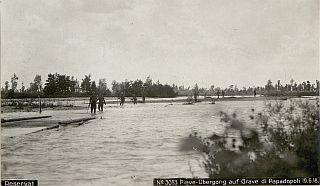
K.u.k. Heer crossing Piave by Grave di Papadopoli
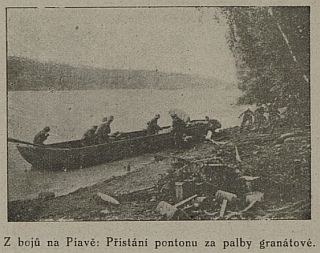
Svět, 12.9.1918
Piave is mentioned by the narrator when he ridicules the officers' servants who bragged about their exploits during the war.
Background
Piave is a river in northern Italy. It flows from the Alps and after 220 km ends in the Adriatic Sea near Venice.
During the war
After the Central Powers broke through by Caporetto 24 October 1917, Italian forces pulled back to the Piave where the front was stabilised in November after the enemy's attempt to cross the river failed. In June 1918 a second battle by the Piave took place. This was the last large-scale Austro-Hungarian operation in the war. The offensive failed and k.u.k. Wehrmacht suffered nearly 120,000 casualties. On 24 October 1918 the Allies attacked across the river and the Austro-Hungarian front collapsed.
By Piave a division of Czech legionnaires were fighting on the Italian side. Those who were captured were publicly executed. On one single day, 22 July 1918, no less than 160 legionnaires suffered this grim fate.
IR. 91 by Piave
During the offensive by Caporetto, IR. 91 followed k.u.k. Wehrmacht westwards from Isonzo to Piave where they arrived on 13 November 1917. For the first month they were stationed at Ponte di Piave, then moved on to Valdobbiadene further up the river.
During the failed Austrian offensive in the summer of 1918 they stayed in the reserve (15 to 23 June), were then moved down the river again to Grave di Papadopoli, a large island in Piave. Finally they were moved to the Serbian front, a transfer that began on 30 September. Amongst the models for characters in the novel only Hans Bigler served by Piave.
Quote(s) from the novel
[I.14.2] Oni šturmovali Sokal, Dubno, Niš, Piavu.
Credit: Jan Ciglbauer, Milan Hodík
Also written:Piavacz
Literature
 | South Bohemia |  | |||
| |||||
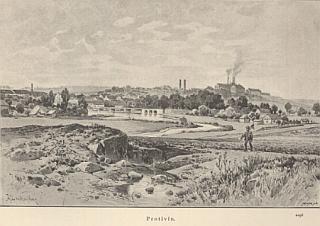
, 1897
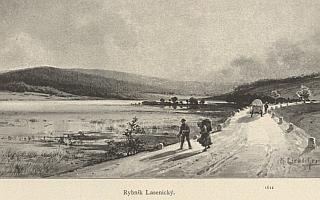
, 1890
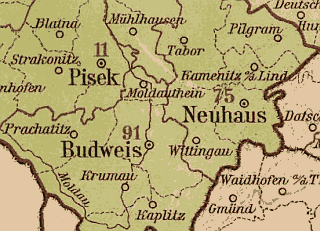
Ergänzungsbezirke Nr. 11, 91, 75
, 1911
South Bohemia is first mentioned when Hašek informs that Oberleutnant Lukáš hails from this region, in the author's own words "the Czech south".
I [I.15] is mentioned again when it is revealed that Oberst Kraus and his regiment got lost during manoeuvres here before the war.
South Bohemia is important in this novel since the plot of slightly more than two of the chapters is set here. Best known is Švejk's anabasis that provides a plethora of geographical references. The rest of the novel also contains details of places and people from the region. Švejk's IR. 91 was recruited from the area so the good soldier came across many people from the Czech south.
It even appears that the good soldier himself hails from the area (see Dražov), and it is directly stated that he did his compulsory military service in Budějovice and also took part in manoeuvres in the region. Amongst important literary figures from the Czech south we find Oberleutnant Lukáš and Offiziersdiener Baloun. Already in the first chapter of the novel South Bohemia is pulled in, see Břetislav Ludvík.
Background
South Bohemia is a vaguely defined geographical area that refers to the area that today roughly makes up Jihočeský kraj (the South Bohemian Region). Capital is České Budějovice, by far the largest city in the region. Amongst other noteable towns are Tábor, Písek, Strakonice, Krumlov, Třeboň, and Jindřichův Hradec. As an administrative entity it was created in 1949 as Budějovický kraj, and from 1960 it has the current name.
Military
Militarily the region reported to 8. Korpskommando and the following recruitment districts were fully or partially contained in this area: 11 (Písek, mostly), 75 (Jindřichův Hradec, mostly), 91 (Budějovice, fully) and 102 (Benešov, a small part).
Hašek and South Bohemia
That South Bohemia has such a prominent place in the novel is closely related to the author's own background. Even though Hašek was from Prague both parents were from the south, and already as a teenager he visited the region with his mother. An important impetus is also his grandfather Jareš, the pond warden from Krč, who told young Jaroslav many stories from the area.
In the end his father's birthplace strongly influenced what setting the author used for the novel from Part Two onwards. Because his father, Josef Hašek, was born in Mydlovary, his son also had Heimatrecht here. As Mydlovary was located in the recruitment district of IR. 91, Jaroslav Hašek was in 1915 called up to serve with this regiment, a fact that decidely influenced the direction of the plot, at least in a geographical sense.
Quote(s) from the novel
[I.14.3] To bylo to, co zachoval z povahy sedláka na českém jihu, kde se narodil ve vesnici mezi černými lesy a rybníky.
[I.15] Nikdy nedorazil nikam včas, vodil pluk v kolonách proti strojním puškám a kdysi před lety stalo se při císařských manévrech na českém jihu, že se úplně s plukem ztratil, dostal se s ním až na Moravu, kde se s ním potloukal ještě několik dní po tom, když už bylo po manévrech a vojáci leželi v kasárnách.
Also written:Jižní ČechyczSüdböhmendeSør-Böhmennn
 | Harz |  | ||||
| ||||||
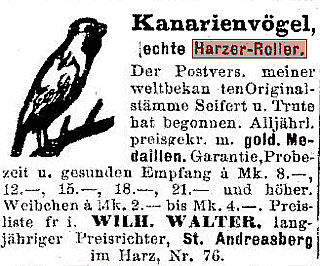
,9.2.1913
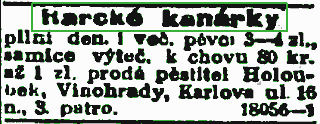
,5.1.1908
Harz is here used as an adjective in reference to a breed of canary birds; the Harzer Roller. The mentioned bird belonged to Oberleutnant Lukáš but suffered a grim fate as Švejk let the bird and the senior lieutenant's cat together "so they could get used to each other".
Background
Harz is a mountain range in Germany. It is the northernmost range in the country and straddles the borders of Lower Saxony, Saxony-Anhalt and Thuringia.
Harzer Roller is a breed of canary birds that was bred in the Harz mountains and was very popular in the 19th century. It is best known as a singing bird but is also used in mines to warn against poisonous gases. It is particularly sensitive to carbon monoxide. The centre for breeding of this race is Sankt Andreasberg.
The breed regularly show up in newspaper adverts from before World War I, for instance in Národní politika. Jaroslav Hašek, who in 1909 and 1910 was editor of the animal magazine Svět zvířat, was very knowledgeable on animals, including birds.
Quote(s) from the novel
[I.14.3] Neobyčejně rád měl zvířata. Měl harckého kanárka, angorskou kočku a stájového pinče.
Literature
 | Canary Islands |  | |||
| |||||

Canary Islands is here used as an adjective in reference to a breed of birds that is named after these islands. Oberleutnant Lukáš was fond of animals and owned a Canary bird, a cat and a dog. The bird ended its life miserably as Švejk tried to let the bird and the cat get used to each other. The result is a foregone conclusion.
Background
Canary Islands is a group of islands in the Atlantic Ocean off the coast of Africa that belong to Spain.
The Canary bird is named after the Canary Islands where it lives in the wild. It is also present on the Azores and Madeira. It was imported to Europe as a domesticated animal, and in Central Europe it became particularly popular. During the 19th century the Harz region became the main centre of canary breeding.
Quote(s) from the novel
[I.14.3] Neobyčejně rád měl zvířata. Měl harckého kanárka, angorskou kočku a stájového pinče.
[I.14.3] „Poslušně hlásím, pane obrlajtnant, že je vše v nejlepším pořádku, jedině kočka dělala neplechu a sežrala vašeho kanára.“
Also written:Kanárské ostrovyczKanarischen InselndeIslas Canariases
 | Pelhřimov |  | |||
| |||||
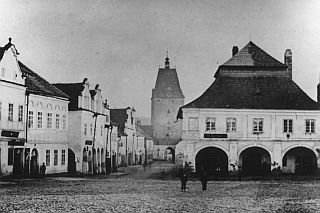
© Pelhřimovský magazín
Pelhřimov is mentioned in a monologue where Švejk tells Oberleutnant Lukáš about a teacher teacher Marek from a village nearby who runs after the daughter of the game-keeper gamekeeper Špera.
The town is mentioned again when Švejk at a railway station in Vienna rejoins his obrlajtnant and immediately tells him about a certain Vaníček from Pelhřimov.
Background
Pelhřimov is a town in Vysočina with around 17,000 inhabitants (2010). It has a well preserved historic centre, and also a certain industrial tradition, for instance in brewing.
Demography
According to the 1910 census Pelhřimov had 5,738 inhabitants of whom 5,729 (99 per cent) reported using Czech in their daily speech. The judicial district was okres Pelhřimov, administratively it reported to hejtmanství Pelhřimov.
Source:Seznam míst v království Českém(1913)
Military
Per the recruitment districts, infantrymen from Pelhřimov were usually assigned to Infanterieregiment Nr. 75 (Neuhaus) or k.k. Landwehrinfanterieregiment Nr. 29 (Budweis).
Quote(s) from the novel
[I.14.3] V jedný vesnici za Pelhřimovem byl nějaký učitel Marek a ten chodil za dcerou hajnýho Špery, a ten mu dal vzkázat, že jestli se bude s holkou scházet v lese, že mu, když ho potká, postí do zadnice z ručnice štětiny se solí.
[II.3] „Vostudu,“ pokračoval Švejk, „jsem vám jistě nikdy neudělal, jestli se něco stalo, to byla náhoda, pouhý řízení boží, jako říkal starej Vaníček z Pelhřimova, když si vodbejval šestatřicátej trest. Nikdy jsem nic neudělal naschvál, pane obrlajtnant, vždycky jsem chtěl udělat něco vobratnýho, dobrýho, a já za to nemůžu, jestli jsme voba z toho neměli žádnej profit a jenom samý pouhý trápení a mučení.“
Also written:Pilgramde
Literature
- Svíčková bába Albrechtová vykládá pohádku, proč nebyl za Pelhřimov zvolen farář Miloš Záruba, Jaroslav Hašek,17.3.1911
 | Košíře |  | |||
| |||||
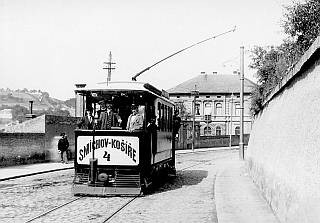
The Hlaváček tramway by Klamovka in June 1897

,17.11.1910
Košíře is mentioned in the dialogue between Oberleutnant Lukáš and Švejk after the cat has eaten the canary. This conversation touches on dog trade and falsification of pedigrees, and Švejk uses a mongrel from Košíře as an example.
In [I.15] the place is mentioned again in the anecdote about some Božetěch who made an income by stealing dogs and then claim rewards.
Background
Košíře is a district in Prague and is located in the western part of the capital, between Smíchov and Motol. Košíře was a separate town from 1895 until it joined greater Praha in 1922. As a curiosity should be mentioned the privatly owned tramway that connect the town with Smíchov centre.
Hašek in Košíře
Jaroslav Hašek officially lived in Košíře no. 908 from 4 February 1909. This was the address the editorial offices of the bi-weekly animal journal Svět zvířat, the journal where he for nearly two years functioned as an editor. The villa was situated above the Klamovka garden but was demolished some time between 2011 and 2015.
From 28 July 1910 shows him registered further down in the town towards Smíchov, in Košíře no. 1125. Here he lived with his wife Jarmila who he had married 23 May 1910. He stayed here (at least officially) until 28 December 1911 when he is recorded with residence Vršovice. It was from no. 1125 that he for a short period, at the end of 1910 and beginning of 1911, ran his unsuccessful "Kynological Institute", buying and selling dogs and other animals.
The birth of Švejk
It was probably during his time in Košíře that the author first through up The Good Soldier Švejk, although in a very different format than the later world famous novel. The first story about Švejk was published 22 May 1911.
Demography
According to the 1910 census Košíře had 12,293 inhabitants of whom 12,233 (99 per cent) reported using Czech in their daily speech. The judicial district was okres Smíchov, administratively it reported to hejtmanství Smíchov. The town consisted of the districts Cibulka, Košíře, Kotlářka, Poštovka and Podhájí. It was served by a post-office and a Roman-Catholic parish.
Source:Seznam míst v království Českém(1913)
Military
Per the recruitment districts, infantrymen from Košíře were usually assigned to Infanterieregiment Nr. 28 (Prag) or k.k. Landwehrinfanterieregiment Nr. 8 (Prag).
Quote(s) from the novel
[I.14.3] A každej hned chtěl rodokmen, tak jsem si musel dát rodokmeny natisknout a dělat z nějakýho košířskýho voříška, kerej se narodil v cihelně, nejčistokrevnějšího šlechtice z bavorskýho psince Armin von Barnheim.
[I.15] Nějakej Božetěch z Košíř, ten se jen tak živil. Ukrad vždycky psa, pak hledal v inzerátech, kdo se zaběh, a hned tam šel.
Credit: Jaroslav Šerák
Also written: KoschirschReinerKoschiřde
Literature
- Demartini a Demartinka,
- Kde všude dál Jaroslav Hašek ouředně bydlel,
- Přátelé zvířat!!, ,25.12.1908
- Kynologický ústav, ,30.11.1910
- Kynologický ústav, Jaroslav Hašek,17.4, 1.5.1914
- Má drahá přitelkyně Julča, Jaroslav Hašek,23.4, 30.4, 7.5.1914
 | Bavaria |  | |||
| |||||
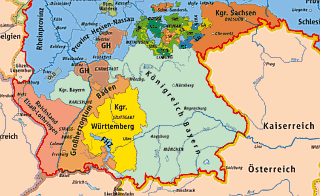
, 1871-1918
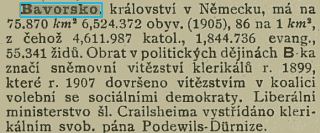
, 1909
Bavaria is mentioned by Švejk in the first conversation with Oberleutnant Lukáš about dogs. In the Bavarian kennel of Armin von Barheim pure breed pinschers are bred.
In [IV.3] Bavaria is mentioned again as soldiers from Infanterieregiment Nr. 91 had been brawling with Bavarians at the square in Żółtańce.
Background
Bavaria is the largest of the German federal states, with Munich as the capital and one of the country's major cities.
The Kingdom of Bavaria existed from 1805 to 1918 and in 1871 it became part of the new united Germany. The geographical extent was somewhat different to that of the modern state as the geographically separate Palatinate belonged to Bavaria.
The kingdom kept a degree of autonomy after the unification: the Wittelsbach dynasty continued its reign, and Bavaria provided its own army, postal and railway services. Bavaria had traditionally been an ally of Austria in conflicts with Prussia, as late as in the German War of 1866 it was at war with Prussia.
In The Good Soldier Švejk there are few references to Bavarian people and places. The most famous Bavarian mentioned is obviously Sisi, then of course the writer Ludwig Ganghofer. References to Bavarian geography are limited to Nuremberg and Nördlingen.
Hašek in Bavaria
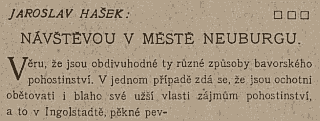
,9.5.1914

Jogelli Klopter and Jaroslav Hašek.
© Josef Lada
Jaroslav Hašek knew parts of Bavaria from his wanderings during the summer of 1904, a journey that inspired him to write a some stories set there. His experiences appear as fragments in many more. According to his won story Velký den (The Big Day) he travelled by foot all the way from Switzerland through Bavaria to Domažlice where he was hosted by his friend Hájek. The journey took place from July and probably until September (the story was printed on 9 October). Hašek's travel in Bavaria is documented only by his own stories, which means that some details must be taken with a pinch of salt. Still we can assume that the greater contours of the journey are factual and that many other details are.
A number places in the former kingdom feature in the various stories. The plot itself takes place in the towns of Dillingen, Höchstädt, Ingolstadt, and Neuburg. All of them are located on the Danube on the stretch between Ingolstadt and the border with Württemberg. In addition Hašek mentions the Bavarian regions Upper Palatinate, Upper Franconia and Swabia. The cities of Passau and Regensburg are mentioned and so are a number of minor places which names are often mystified or misspelt.
Three of the stories are set in Neuburg, and the best known of these describe a meeting with the fat tourist guide Jogelli Klopter. The story has been translated to several foreign languages, amongst them English. Another well known story is titled Justice in Bavaria and is set in Ingolstadt. Here the author is arrested as a vagrant but is quite satisfied with the conditions in the prisons and the terms of his sentence in general.
A story about hop-picking is set in the area between Nuremberg and Spalt. Here he describes his meeting with other seasonal workers, amongst them a man from Schleswig.
In 1917 Jaroslav Hašek published the story Na Valhallu in Čechoslovan in Kiev [a]. The story which is more propaganda than entertainment, does however mention a number og places along the river Regen and indicates a journey back to Bohemia through the Bavarian Forest in 1904. Mentioned are the Walhalla monument by Donaustauf, Furth im Wald and Eschlkam. He also indicates where he crossed the border.
Quote(s) from the novel
[I.14.3] A každej hned chtěl rodokmen, tak jsem si musel dát rodokmeny natisknout a dělat z nějakýho košířskýho voříška, kerej se narodil v cihelně, nejčistokrevnějšího šlechtice z bavorskýho psince Armin von Barheim.
Credit: Jan Berwid-Buquoy, Radko Pytlík
Also written:Bavorskocz
Literature
- Bavorsko,
- Staatsgebiet, Thomas Paringer
- Velký den, Jaroslav Hašek,9.10.1904
- Při česání chmele, Jaroslav Hašek,3.11.1904
- Průvodčí cizinců a jiné satiry z cest i domova, ,1913
- Průvodčí cizinců ve švábském městě Neuburgu, ,1913
- Můj přítel Hanuška, Jaroslav Hašek,5.10.1913
- Návštěvou v městě Neuburgu, Jaroslav Hašek,9.5.1914
- Na Valhallu, Dr. Vladimír Stanko,9.4.1917J [a]
- Přátelský zápas mezi "Tillingen" a "Höchstädt", Jaroslav Hašek,10.7.1921
| a | Na Valhallu | Dr. Vladimír Stanko | 9.4.1917J |
 | Vojtěšská ulice |  | |||
| |||||
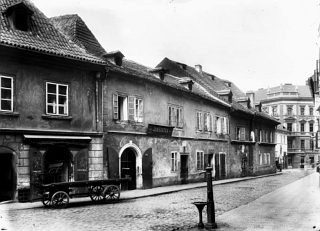
Vojtěšská ulice, Nové město, Praha. © AHMP
Vojtěšská ulice is mentioned by Švejk in connection with Oberleutnant Lukáš' troubles when Katy Wendler appears. In his anecdote it was also talk of a visiting lady who didn't know her allotted time. The incident with the lady allegedly took place "two years ago", in other words in 1912.
Background
Vojtěšská ulice is a street in Nové město, running parallel to Vltava north of Myslíkova ulice. The street is named after St Adalbert. The main attraction in the street is probably church Kostel sv. Vojtěcha většího. There is also an identically named street in Břevnov but it is unlikely that Švejk had this street in mind.
It has not been possible to link the mentioned episode to any news items from the period in question.
Quote(s) from the novel
[I.14.4] „Poslušně hlásím, pane obrlajtnant, že je to těžký případ. Ve Vojtěšský ulici před dvěma léty nastěhovala se k jednomu čalouníkovi nějaká slečna a von ji nemoh vypudit z bytu a musel votrávit ji i sebe svítiplynem a bylo po legraci. S ženskejma je vobtíž. Já do nich vidím.“
Also written:Adalbertgassede
Literature
 | Třeboň |  | |||
| |||||
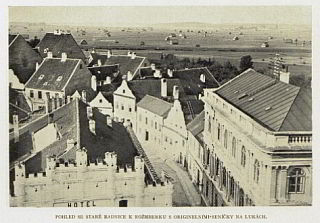
, 18.10.1912
Třeboň was the town Mrs. Micková came from. Oberleutnant Lukáš expected a visit from here just at the moment Katy Wendler inconveniently arrived.
Background
Třeboň is a town in South Bohemia with around 8,700 inhabitants (2010). It was one of the main centres of the Schwarzenberg estates, has a fine historic old town and is surrounded by rybníky, artificial lakes used for fish-breeding. It is also classified as a spa town. Třeboň had in 1914 direct railway connection with Prague and Vienna.
Demography
According to the 1910 census Třeboň had 5,278 inhabitants of whom 5,098 (96 per cent) reported using Czech in their daily speech. The judicial district was okres Třeboň, administratively it reported to hejtmanství Třeboň.
Source:Seznam míst v království Českém(1913)
Military
Per the recruitment districts, infantrymen from Třeboň were usually assigned to Infanterieregiment Nr. 75 (Neuhaus) or k.k. Landwehrinfanterieregiment Nr. 29 (Budweis). There was also a military presence in town - of the 341 employed by the armed forces most were Czechs. In 1912 the 1st battalion of Infanterieregiment Nr. 88 were garrisoned in Třeboň, but by 1913 they had been transferred to Jindřichův Hradec. At the moment we don't know who used the barrack in Třeboň by the outbreak of or during the war.
Quote(s) from the novel
[I.14.4] Milý Jindřich byl určitě v ošklivé situaci. Manželka pronásledovaná manželem přijede k němu na několik dní na návštěvu, právě když má přijeti paní Micková z Třeboně, aby po tři dny opakovala to, co mu pravidelně poskytuje každého čtvrt roku, když jede do Prahy dělat nákupy.
Also written:Wittingaude
Literature
 | Memphis |  | ||||
| ||||||

,3.3.1897

, 26.2.1909

, 16.5.1918
Memphis is here used as an adjective in the expression "a packet of Memphis cigarettes", in Czech "krabice memfisek". Švejk was ordered by Oberleutnant Lukáš to buy wine and cigarettes for Katy Wendler. The cigarettes are mentioned three times in this chapter.
Background
Memphis is here mentioned through the cigarette brand Memphis that was manufactured by the tobacco-monopoly Kaiserlich königliche Tabak-regie. The cigarettes were made in Hainburg and a number of other places. In 1882 there we 28 tobacco factories in Cisleithania, i.e. the Austrian half of the Dual Monarchy, but details on which factory made what brand are not available.
The brand was launched in 1897 and was in 1913 the third most sold brand in the Austrian part of the Dual Monarchy. The name refers to Memphis in ancient Egypt, not to the US metropolis. Many of the Austrian cigarette brand names had an Oriental association (Nil, Stambul, Sultan, Memphis etc.).
Memphis cigarettes continued to be produced in post-war Czechoslovakia and Austria, by the successor states' respective tobacco monopolies. In Austria the monopoly was abolished as late as 1996 and the Memphis cigarette exists even today (2019), although it is no longer made in the country. The last domestic tobacco factory (Hainburg) closed down in 2011.
The Good Soldier Švejk in Captivity
The cigarettes are mentioned also in Dobrý voják Švejk v zajetí where they figure durings Švejk's stay at c.k. policejní ředitelství.[1]
Pak zavolali místodržitelského radu k výslechu a za půl hodiny přišel strážník a doručil do separace od místodržitelského rady Švejkovi krabičku se sto memfiskami. Na krabičce bylo napsáno: "Auf freien Fuss gesetzt." (Propuštěn na svobodu.) Memfisky dodaly Švejkovi opět ducha. Rozdělil se o ně se zatčenými, jen mladík s černou vázankou nepřijal ani jedné cigarety.
Quote(s) from the novel
[I.14.4] Pak koupíte tři láhve vína, krabičku memfisek, tak.
[I.14.4] Dostal jsem na to vod pana obrlajtnanta sto korun, ale z toho musím koupit tři lahve vína a krabičku memfisek.“
[I.14.4] Při obědě vypila láhev vína, vykouřila mnoho memfisek a lehla si do postele, zatímco Švejk v kuchyni pochutnával si na komisárku, který namáčel do sklenice s nějakou sladkou kořalkou.
Literature
- Kaiserlich Königliche Tabakregie,
- Memphis,
- Praktisches Handbuch für den Finanz-Verwaltungsdienst in Österreich-Ungarn, ,1882
- Ein Raucherstatistik, ,28.12.1906
- Tabák u nás, ,4.7.1913
- Aus für Zigaretten Made in Austria, ,5.11.2011
- Dobrý voják Švejk v zajetí, ,1917 [1]
| 1 | Dobrý voják Švejk v zajetí | 1917 |
 | Dunajec |  | ||||
| ||||||
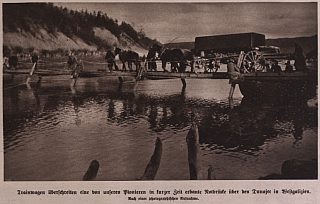
,25.2.1915
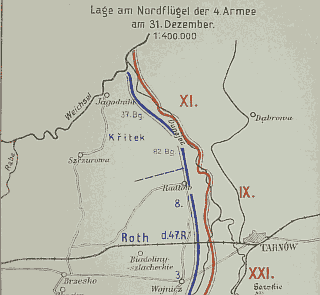
Österreich-Ungarns letzter Krieg (Band 1)

,1915

,8.5.1915

,1915
Dunajec was mentioned by the author when he describes the war situation and the "war council" Oberleutnant Lukáš and Švejk held to get rid of Katy Wendler. He notes that this was at the time when the masses of the armies stood in a rain of shells in the forests by Dunajec and Raba and that heavy artillery tore apart entire companies and dispersed them in the Carpathians.
Soon after, when hop trader Wendler has arrived to pick up his wife, Oberleutnant Lukáš mentions the river for his guest when he explains the positive outlook for the war.
Background
Dunajec is a river that flows through northern Slovakia and southern Poland. It is one of the tributaries of Vistula which it joins by Opatowiec, north of Tarnów.
From 15 November 1914 the 3rd Russian Army led by Radko Dimitrov crossed the river and advanced across Raba towards Kraków. On 8 December they were forced back (battle of Limanowa) and by the end of the year the front had stabilised by Dunajec.
Until May 1915 part of the front stretched along Dunajec and fierce fighting took place through the winter. The situation changed to the advantage of the Central Powers after the breakthrough by Gorlice and Tarnów on 2 May 1915 and the area was thereafter spared from further destruction.
The novel's timing
The author mentions fighting by Raba and Dunajec in the same sentence so time-wise so the author surely has the period from 15 November 1914 until the turn of the year in mind. It was precisely in this period that the Russian army operated beyond Dunajec, and nearly reached Kraków. This corresponds with one of the very few dates mentioned in the novel: on 20 December 1914 Oberleutnant Lukáš dictated a letter for Švejk to send Katy Wendler as thanks for the 400 crowns she left on the washbasin as thanks for his services.
Quote from the World War Chronicle
The quote from the conversation between Oberleutnant Lukáš and hop trader Wendler is copied directly from page 508 of Kronika světové války. It refers to events that took place as late as 2 May 1915.
Even the author's introduction to the sub-chapter can be traced to the Chronicle but here Hašek replaced the river Biała with Raba, preseumably to align the plot with the situation at the front in December 1914. This quote also refers to events that took place in early May, more precisely the re-conquest of Tarnów by the Central Powers. It was originally reported in Berliner Tageblatt on 8 May 1915 and reproduced in several German and Austrian newspapers during the upcoming days.
Quote(s) from the novel
[I.14.5] Zatímco masy vojsk připnuté na lesích u Dunajce i Rábu stály pod deštěm granátů a velkokalibrová děla roztrhávala celé setniny a zasypávala je v Karpatech a obzory na všech bojištích hořely od požárů vesnic i měst, prožíval nadporučík Lukáš se Švejk nepříjemnou idylu s dámou, která utekla svému muži a dělala nyní domácí paní.
[I.14.5] Jakmile však prolomíme ruskou frontu mezi karpatským hřbetem a středním Dunajcem, není nijaké pochybnosti, že bude to znamenat konec války.
Also written:Dunajetzde
Literature
- Österreich-Ungarns letzter Krieg 1914-1918 (Erster Band), ,1930-1936
- Bitva u Limanově,
- Oj Dunajec biala wôda..., Jar. Hašek,10.2.1902
- Die Auflösung der russichen Beskidenarmee, ,9.5.1915
 | Všenory |  | |||
| |||||
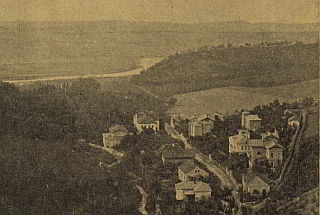
Brda a Podbrdí, , 1925

, 10.10.1912
Všenory is mentioned in a story Švejk tells to illustrate for Oberleutnant Lukáš the problems of getting Katy Wendler out of the house.
Background
Všenory is a village around 20 km south west of Prague, by the river Berounka. In 2018 it had 1,640 inhabitants.
Demography
According to the 1910 census Všenory had 289 inhabitants of whom 289 (100 per cent) reported using Czech in their daily speech. The judicial district was okres Zbraslav, administratively it reported to hejtmanství Smíchov. The Catholic parish was Mokropsy Horní a Trnová, the post office was located in Dobřichovice.
Source:Seznam míst v království Českém(1913)
Military
Per the recruitment districts, infantrymen from Všenory were usually assigned to Infanterieregiment Nr. 28 (Prag) or k.k. Landwehrinfanterieregiment Nr. 8 (Prag).
Quote(s) from the novel
[I.14.5] Ve Všenorech byl minulej rok takovej případ v jedný vile. Ale tenkrát si ten telegram poslala sama ta ženská svýmu muži a ten si pro ni přijel a nafackoval voboum. Voba byli civilisti, ale v tomto případě si na oficíra nebude troufat.
Also written:Wšenorde
Literature
 | Paris |  | |||
| |||||

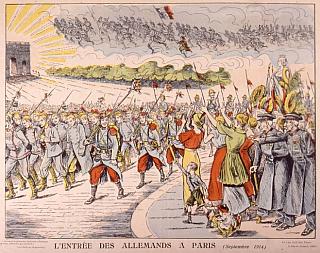
L'entrée des Allemands à Paris (Septembre 1914)
Paris will according to Oberleutnant Lukáš soon be in German hands. This claim is part of his lecture to hop trader Wendler about the military situation.
The hop trader later in the conversation asks the officer why the Germans had withdrawn to the border when they already had been close to Paris.
Background
Paris is the capital and the largest city in France. The city core has a population of around 2.1 million, whereas the metropolitan area, which is the fourth largest Europe, has around 12 million.
The French capital was for a while in August and September 1914 seriously threatened by the initial German advance, but the enemy was halted in the battle of Marne.
Paris is also mentioned in some of Jaroslav Hašek's short stories, see links below.
Quote(s) from the novel
[I.14.5] Stejně Francouzům hrozí v nejkratší době ztráta celé východní Francie a vtržení německého vojska do Paříže.
[I.14.5] Nemyslete si, že nesleduji události,“ pokračoval, dívaje se zuřivě na nadporučíka, který klidně vypouštěl z úst kolečka cigaretového dýmu, která stíhala jedno za druhým a rozbíjela je, což sledovala paní Katy s velkým zájmem, „proč Němci odešli zpět ku hranicím, když byli již u Paříže?
Also written:Pařížcz
Literature
- Básník Toman praví: Monsieur, n’avez-vous pas une coronne?,
- Ministři Dr. Žáček a Dr. Bráf, Jaroslav Hašek,2.11.1909
- Schůze panské sněmovny, Jaroslav Hašek,9.1.1911
- Státoprávní deník Samostatnost, Jaroslav Hašek,27.11.1911
- Různé hlasy listů o drahotě, Jaroslav Hašek,5.1.1912
- Mezinárodní a česká situace, Jaroslav Hašek,6.7.1912
 | Východní Beskydy |  | |||
| |||||

,11.5.1915

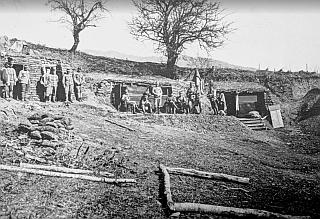
IR. 91, Kistopolya, 23.4.1915. Bestand Rudolf Kießwetter
© ÖStA
Východní Beskydy is part of the lecture about the war situation that Oberleutnant Lukáš treats hop trader Wendler to. From [II.3] onwards, events from here are often mentioned through stories from veterans who have served with Infanterieregiment Nr. 91 in the Carpathians. By Medzilaborce and Palota the plot takes place here without the mountains being mentioned explicitly.
Background
Východní Beskydy (Eastern Beskids) is a mountain region straddling the border between Poland, Slovakia and Ukraine, in Polish called Bieszczady. From the autumn of 1914 until May 1915 the front went along the mountains which saw heavy fighting during the winter battle of the Carpathians.
The novel apparently refers to battles that took place at the beginning of April 1915 east of Medzilaborce. Many of the official bulletins from this period mentions the fighting in Ostbeskiden. This assumption is supported by the fact that the author picked most of the information he used in the conversation between Oberleutnant Lukáš and hop trader Wendler from these very announcements.
The news entry in Kronika světové války from 2 April 1915 mentions Východní Beskydy as well as Klosterhoek, Niederaspach and Mühlhausen. All these places feature in the conversation between hop trader Wendler and Oberleutnant Lukáš. Also note that the spelling "Bezkydy" was often used, for instance in the mentioned news item.
IR. 91 in the Eastern Beskids
Until the first week of May 1915 three battalions of Infanterieregiment Nr. 91 were stationed at this section of the front. They had been transferred from the Balkans front in early February. Their stay here has surely provided material for many of the conversation in Part Three. On 22 March 1915 the regiment suffered one of their worst days of the entire war. By Malá Zolobina they were overrun by a surprise Russian attack and three companies were captured and several others severely decimated. Eight officers (amongst the two captains) were taken prisoner and Verlustliste for this and the next day conatins around 600 entries! See also 9. Marschkompanie.
Several of the models for characters in the novel served here: Rudolf Lukas, Jan Vaněk, Jan Eybl, Josef Adamička and also the more peripheral Oberleutnant Wurm. The activities of the regimentet in these mountains are very well documented through the diaries of Eybl.
Quote(s) from the novel
[I.14.5] Nadporučík Lukáš vzal obchodníka s chmelem jemně za rameno a odvedl k mapě bojiště, visící na stěně, a ukazuje mu jednotlivé body, vykládal: „Východní Beskydy jsou naším znamenitým opěrným bodem.
Also written:Eastern BeskidsenOstbeskidendeAust-BeskidanenoСхідні_Бескидиuk
Literature
- V Karpatech po stopách jednadevadesátníků,
- Das Infanterieregiment Nr. 91 am Vormarsch in Galizien, ,1927
- Die Verschiebung des Infanterieregemntes Nr. 91 auf den nördlichen Kriegsschauplatz, Karl Wagner-Wagenried,1924-1928
- První světová válka v denících feldkuráta P. Jana Evangelisty Eybla, II., ,2015
- Bezkydy!, ,27.12.1914
- Der amtlicher Bericht unseres Generalstabes, ,3.4.1915
- Přehled dosadavních událostí válečných, ,4.4.1915
 | Moscow |  | |||
| |||||

, 27.9.1912

, 1901
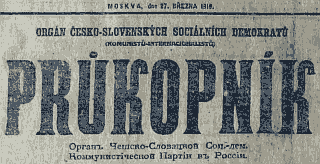
, 27.3.1918
Moscow is one of the many places that are part of Oberleutnant Lukáš' lecture for hop trader Wendler about the war situation. He assures the hop trader that "we are not going to stop until we reach Moscow".
In [II.1] it is mentioned again when Švejk marched from Tábor in the winter landscape, as a soldier in Napoléon's army during the retreat from Moscow.
Background
Moscow [Москва] was in 1914 the biggest city in Russia whereas Petrograd was the capital. Moscow was from 1922 capital of the Soviet Union and was also the centre of the Bolshevik administration from 12 March 1918. It is the capital and biggest city of the modern republic of Russia, with more than 10 millions inhabitants. The city is situated on the river Moscow, 142 metres above sea level.
In 1897 the city had 988,614 inhabitants and the vast majority were Russians. The largest minority were Germans and Jews but none of these groups counted for more than 3 per cent of the population. There were also a number of Czechs and several Czech firms had offices in Moscow. During the last decennials before the world war the city was growing rapidly, had a diverse industrial base and was also the hub of the Russian railway network, connection 10 lines.
Hašek in Moscow
Jaroslav Hašek arrived in the city in mid March 1918 together Břetislav Hůla. It was here he joined the Czech section of the Communist Party and started to campaign for České legie to remain in Russia. On 27 March 1918 he published an article in Průkopník titled "To the Czech Army: why is one going to France?". He argued against the Legion's transfer to the Western front and though they should remain in Russia to defend the revolution.
His stay in the city was short-lived as he left for Samara in early April. In November 1920 he appeared in Moscow again, now on the way back to his homeland after working for two years as a Red Army commissar in the Ural region and Siberia.
The Good Soldier Švejk in Captivity
In Dobrý voják Švejk v zajetí Moscow is mentioned during Švejk's stay at a psychiatric clinic in Vienna. One of the inmates claims to be Archduke Friedrich and that "we will be in Moscow in a month".[1]
Tam v rohu chodby seděl například člověk, kaprál, který křičel, že je arcivévoda Bedřich a že za měsíc bude v Moskvě. Toho zavřeli na pozorování, ale nesmíme zapomenouti že skutečný arcivévoda Bedřich se jednou sám tak vyjádřil a nestalo se mu nic, jen utrpěl trochu blamáže.
Quote(s) from the novel
[I.14.5] V karpatských úsecích, jak vidíte, máme velkou oporu. Mocný úder na tuto linii - a nezastavíme se až v Moskvě. Válka skončí dřív, než se nadějeme.“
[II.1] Šel sněhy silnice, ve mraze, zahalen v svůj vojenský plášť, jako poslední z gardy Napoleonovy vracející se z výpravy na Moskvu, s tím toliko rozdílem,...
Also written:MoskvaczMoskaudeМоскваru
Literature
- К oslavě památného stoletého výročí bitvy u Borodina, ,27.9.1912
- Jaroslav Hašek - komisař bolševiků, Václav Menger,7.5.1933
- Jaroslav Hašek. Vzpominky Šury Lvové-Haškové,
- Dobrý voják Švejk v zajetí, ,1917 [1]
| 1 | Dobrý voják Švejk v zajetí | 1917 |
 | Dardanelles |  | |||
| |||||
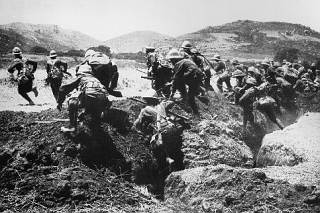
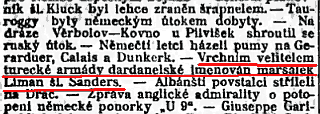
,4.4.1915
Dardanelles is part of summary Oberleutnant Lukáš provides hop trader Wendler with about the situation at the various fronts. The officer informs his gueast that Marschall Liman von Sanders has been named head commander of the Dardanell army.
Background
Dardanelles is a narrow strait in north western Turkey that connects the Aegean Sea and the Marmara Sea. In March 1915 allied forces attempted to force their way through the straits but were repelled. The defeat ultimately led to the forced resignation of the British minister of Naval Affairs, Winston Churchill. The first major battle was fought on 18 March 1915 and the allied invasion fleet was repelled. The defenders were led by Cevat Paşa, later known as hero of 18 March.
Marschall Liman von Sanders was named commander-in-chief of the Dardanelle army on 24 March 1915, and the news about his new role was pasted directly in to the novel. It was cut from a summary of the latest events that was printed in Národní politika on Easter Sunday 1915 (4 April).
Quote(s) from the novel
[I.14.5] Vrchním velitelem turecké armády dardanelské jmenován maršálek Liman šl. Sanders.
Also written:DardanelyczDardanellendeÇanakkale Boğazıtr
Literature
 | Constantinople |  | |||
| |||||

, 15.5.1915

, s. 506
Constantinople is included in Oberleutnant Lukáš's elaborations for hop trader Wendler on the war situation. Here he informs his guest that Goltz Paşa has arrived in Berlin from Constantinople.
Later in the conversation the hop trader informs that he had delivered hops even to all the way to Constantinople before the war but that this trade now has stopped.
In the novel the obrlajtnant uses the term "Cařihrad" (Emperor's City), but this is rarely used in modern Czech. In Slovenian (Carigrad) and Bulgarian this form still exist, but in the other Slav languages it is now obsolete.
Background
Constantinople was in 1914 capital and the largest city of the Ottoman empire, and was capital of the new republic of Turkey until 1923. From 1930 the city has been known as İstanbul.
Goltz Paşa's journey from Constantinople to Berlin that Oberleutnant Lukáš refers to actually took place, but his arrival was on 29 March 1915, not in December 1914 as the novel indicates. The sentence that refers to Constantinople is one of many direct quotes from Kronika světové války. The quote also appeared in Národní politika 4 April 1915.
Quote(s) from the novel
[I.14.5] Goltz paša přijel z Cařihradu do Berlína a naším císařem byli vyznamenáni Enver paša, viceadmirál Usedon paša a generál Dževad paša.
[I.14.5] Náš chmel šel až do Cařihradu. Dnes jsme napolo zničeni.
Also written:CařihradHašekKonstantinopolczKonstantinyétr
Literature
 | Berlin |  | |||
| |||||

Brandenburger Tor in 1914
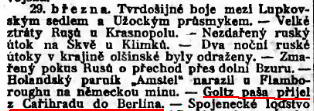
,4.4.1915
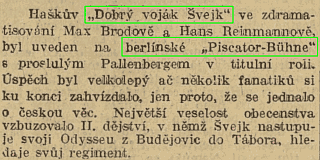
,24.1.1928
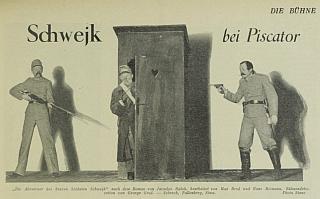
,1928
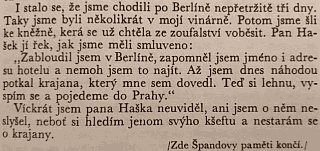
The end of Longen's fanciful story about Hašek and the former police man "Španda" in Berlin

Hašek's wife does not record any stay in Berlin
Berlin is mentioned 5 times in The Good Soldier Švejk.
Berlin is also part of Oberleutnant Lukáš' lecture for hop trader Wendler about the military situation. The senior lieutenant informs his guest that Goltz Paşa has arrived in the city from Constantinople.
Berlin is later touched on when Blahník and Švejk invent the pedigree of Max (Fox) (see Berliner Stallpinscherausstellung ) and also in (2,4) in connection with Krauss and his publishing of graffiti from some railway station toilets there. In [II.3] Einjährigfreiwilliger Marek mentions a poultry exhibition in Berlin (see Wyandotte).
Background
Berlin is the capital of Germany and its largest city, counting around 3.6 million inhabitants (2017). It is located by the river Spree and is situated appx. 35 metres above sea level.
The city was from 1871 capital of Germany and already before that capital of the kingdom of Prussia and until 1881 the province of Brandenburg. Some of the political decisions that led to the outbreak of war were taken here. In 1900 the population count was around 2 millions and was growing rapidly. The city had at the time a very different appearance because it was largely left in rubble during the Second World War.
Oberleutnant Lukáš' statement refers to the arrival of Goltz Paşa in Berlin on 29 March 1915. Also note that the relevant phrase in the novel is word-by-word to identical to the newspaper clip to the right. See Kronika světové války for more on press quotes used in the novel.
Berlin and Švejk
Berlin, in its own right, merits a place in the story of how Švejk became famous outside his home country. Erwin Piscator's theatre play on Piscator-Bühne at Nollendrofplatz contributed a lot to the fame of the good soldier. The play was enthusiastically received by the public as well as critics, and the success was noted also abroad. Max Pallenberg played Švejk and the script was written by Hans Reimann and Max Brod. The play was first performed 23 January 1928.
Another Berliner who pushed Švejk into the limelight was Kurt Tucholsky who in 1926 wrote a raving review of the two first volumes of the novel (i.e. the translation).
Hašek in Berlin?
Jaroslav Hašek and his wife Alexandra Lvova (Šura) must have passed through the city around 9 December 1920. They were on the way to Czechoslovakia from Russia and they had arrived in Swinemünde (now Świnoujście) by boat the previous evening. Emil Artur Longen claims that they spend some days in Berlin after bumping into Vincenc Španda at Unter den Linden.
Španda was allegedly a former policeman from Prague who knew the author already in 1911 in connection Strana mírného pokroku v mezích zákona. Jaroslav Hašek and Španda are supposed to have partied in Berlin for three days and the author excused himself to his wife by claiming he had got lost!
Still there is every reason to be sceptical of Longen's version. First and foremost because Lvova doesn't mention Berlin or her husbands alleged three day "disappearance" in her account of their journey. On the contrary she recalls that they left Stettin (now Szczecin) in the evening of 9 December with an evening train and arrived in Pardubice "at night" (probably the night from 10 to 11 December).
Nor is there any trace of any policeman Španda in the address books of pre-war Prague or in the 1920 Berlin equivalent (perhaps Španda was not his real name). Amongst Hašek-experts Longen is moreover regarded an unreliable source. Radko Pytlík still doesn't rule out the possibility of a short stay in Berlin. He also writes that some Antonín Rypl was on the same journey as Hašek, but we know from official documents that Rypl arrived in Pardubice already on 10 December 1920. This fits well with Lvova's version, so any claim that Jaroslav Hašek stayed in Berlin for several days is probably based on hearsay..
Kurt Tucholsky
Zu diesem Buch ist mir in der gesamten Literatur kein Gegenstück bekannt.
Quote(s) from the novel
[I.14.5] Goltz paša přijel z Cařihradu do Berlína a naším císařem byli vyznamenáni Enver paša, viceadmirál Usedom paša a generál Dževad paša.
[I.14.6] Otec obdržel první cenu na berlínský výstavě stájových pinčů v roce 1912.
[II.3] Opět mne přerušil a řekl, že mu to úplné stačí, a jestli jen polovičku toho podaří se mně splnit, že mně daruje párek trpasličích wyandotek z poslední berlínské výstavy drůbeže, které obdržely první cenu a majitel zlatou medaili za výborné spáření.
Credit: Radko Pytlík, Emil Artur Longen, Alexandra Lvova-Haškova, Jan Berwid-Buquoy
Also written:Berlíncz
Literature
- Digitale Landesbibliothek Berlin,
- Berlin, ,1905
- Berlín,
- Türkisches bei Schwejk,
- Kronika světové války,
- Jaroslav Hašek. Vzpominky Šury Lvové-Haškové,
- Herr Schwejk, Kurt Tucholsky,1926
- Schwejk der Zweite, Kurt Tucholsky,1926
- Schwejk bei Piscator, ,1928
- "Schwejk" bei Piscator in Berlin, Richard Rosenheim,24.1.1928
- "Schwejk" bei Piscator, ,25.1.1928
- In Berlin macht man sich über Österreich lustig, ,28.1.1928
- "Schwejk" als Oper von Brecht-Weill, ,21.5.1930
 | Vistula |  | |||
| |||||
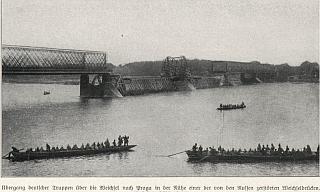
,19.8.1915

, 1915
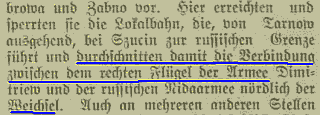
,9.5.1915
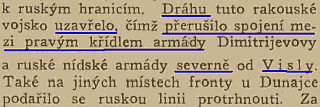
, 1915
Vistula is also pulled in by Oberleutnant Lukáš in his long discourse for hop trader Wendler on the strategic situation. This is the last item before the unavoidable theme is introduced: Katy Wendler.
Background
Vistula is with its 1,047 km the longest river in Poland. It flows through cities like Kraków, Warsaw, Torun and Gdańsk. The catchment area covers half of Polen.
Throughout the autumn of 1914 and until late summer 1915 the war zone engulfed parts of river basin. In the context of The Good Soldier Švejk it is however the upper stretch that is the theme, as it was on Austrian territory.
Quotes from the War Chronicle
As with many other fragments from the conversation between Oberleutnant Lukáš and hop trader Wendler it seems that the author has borrowed some phrases from Kronika světové války. In this case they are however not copied word by word, and some details are removed or thrown about. The fragment refers to the Central Powers breakthrough by Dunajec in early May 1915 and is based on a report published in Berliner Tageblatt on 8 May 1915 and reproduced by Teplitz-Schönauer Anzeiger the next day[a].
Quote(s) from the novel
[I.14.5] Nadporučík Lukáš, vida, že spád rozmluvy zabočuje do nepříjemností, odvedl opět inteligentního obchodníka s chmelem k mapě bojiště, a ukazuje na podtržená místa, řekl: „Zapomněl jsem vás upozornit na jednu velice zajímavou okolnost. Na tento veliký, k jihozápadu obrácený oblouk, kde tvoří tato skupina hor veliké předmostí. Sem obrácena jest ofensiva spojenců. Uzavřením této dráhy, která předmostí spojuje s hlavní obrannou linií nepřítele, musí být přerušeno spojení mezi pravým křídlem a severní armádou na Visle. Je vám to nyní jasné?“
Also written:VislaczWeichselde
Literature
- Die Auflösung der russichen Beskidenarmee, ,8.5.1915
- Die Auflösung der russichen Beskidenarmee, ,9.5.1915
- Vypomínka na močálů, Jaroslav Hašek,24.7.1903
- Mezi tuláky, Jaroslav Hašek,10.2.1905
 | Italy |  | |||
| |||||

, 10.12.1912
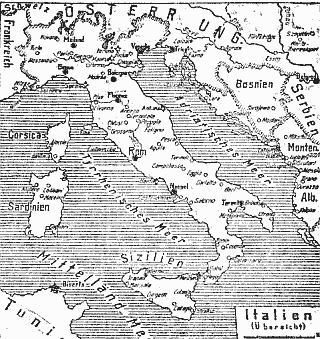
, 25.5.1915
Italy is in The Good Soldier Švejk first mentioned by hop trader Wendler in his complaint to Oberleutnant Lukáš about the effect of the war on the hop trade. He states that exports to Italy still carry on but that he is worried about the intentions of the Italians. He complains that Italy is still neutral despite renewing the Triple Alliance as late as in 1912.
From [III.2] onwards Italy features increasingly in The Good Soldier Švejk due to her declaration of war on Austria-Hungary. Many places in Italy are mentioned, mostly mid 19th century battlefields in the north during the three wars with Austria. These include Solferino, Custoza, Caldiero, Santa Lucia and Piave. Italian cities are also drawn in, amongst them Milan, Venice, Verona, and Novara. Amongst political entities we find Sardinia, Piedmont and the Venetian Republic.
Many distinguished Italians have their names mentioned in The Good Soldier Švejk. First introduced is Columbus, followed by Lombroso, Boccaccio, Dante, Giordano Bruno, Galileo, marchese di San Giuliano, and King Carlo Alberto.
Background
Italy was in 1914 a kingdom that had been united since 1861. The capital was Rome and the population in 1914 was 37 million. On the eve of World War I the area was the same as today with the exception of Trentino, Alto Agide (South Tyrol) and Trieste. The latter territories belonged to Austria until 1918 and were handed over to Italy as part of the peace settlement. Italy was also a colonial power, possessing Libya (from 1912) and also parts of eastern Africa.
Austria-Hungary had a sizable Italian minority, predominantly on the Istria peninsula and in Trentino. Italian sepakers made up 1.5 per cent of the empire's population, or about 750,000. Italian was one of 10 official languages and Italians were represented in the Austrian Reichsrat. Almost the entire Italian population lived in Cisleithania. The Italian minority of Austria was a source of permanent conflict, as Italy made claims to the areas in where they lived. These territorial demands were in the end the main reason for Italy entering the war on the side of the Entente.
Three wars against Austria
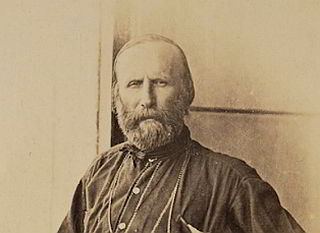
National hero Giuseppe Garibaldi took part in all three Italian wars of independence against Austria
Between 1848 and 1866 three wars were fought between Austria and various Italian states. These are usually referred to as the first, second and third Italian war of liberation. It is in connection with these wars that most of the battlefields are mentioned later in the novel.
In the first war of liberation (1848-49) the kingdom of Sardinia faced Austria on its own and were defeated by Custoza and Santa Lucia, in battles where the Austrian army was commanded by the 82 year old Marschall Radetzky. Austria's victory did however not result in territorial gains, but Sardinia had to pay war reparations.
Leading up to the second war of liberation (1859) the kingdom of Sardinia had realised that they were incapable of winning a war against Austria alone, and allied themselves with France. After having provoked the war they won a decisive battle at Solferino. The result was that Austria was forced to cede Lombardy.
In the third war of liberation (1866) the now united Italy was allied with Prussia. Despite not winning any victory on the battlefield they were awarded the province of Veneto as Austria's position was untenable after her defeat against Prussia by Hradec Králové (Königgrätz).
The Triple Alliance
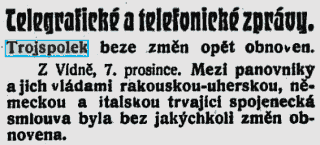
,8.12.1912
The mentioned Triple Alliance (de. Dreibund, it. Triplice alleanza) was a loose defensive alliance between Germany, Austria-Hungary and Italy. It was first signed in 1879 between the former two states, and in 1882 Italy joined. Their strategic reason was to have back cover for their colonial ambitions in Africa where they competed with France and England. This despite their long-standing conflict with Austria over Italian-speaking areas in Trentino, South Tyrol and on the Istria peninsula. Mussolini's newspaper with news on the renouncement of the Triple Alliance. , 7.5.1915
The obligations of the treaty were limited to supporting the partners in the event of one of them being attacked by two or more non-treaty states. The treaty also contained an extra clause, stating that Italy would not be obliged to enter a war against England.
The treaty was renewed five times, the latest signed on 5 December 1912 by Foreign Secretary marchese di San Giuliano in Vienna. The only change from the 4th treaty (1902) was that Austria-Hungary and Germany recognized Italy's rule in Libya, an area she had conquered from Turkey during the war earlier that year.
The road to war
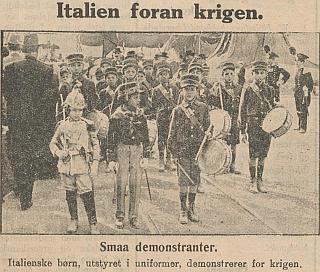
Italian children in pro-war demonstration.
, 31.5.1915
In august 1914 Italy declared neutrality. The country was not obliged to participate in the war against Serbia, as the latter was clearly not the aggressor. Then they undertook negotiations with the warring parties, seeking to exploit the situation to achieve its territorial and political goals. The Entente obviously had more to offer and Italy pulled out of the Triple Alliance on 4 May 1915 after having entered as secret agreement to go to war against the Central Powers (the London agreement 26 April 1915).
In parallel negotiations Austria-Hungary was willing to concede major areas to keep Italy neutral, but in the London treaty the Entente had promised them even more.
One of the most vocal proponents of war was the young socialist politician and journalist Benito Mussolini. In November 1914 he founded his own newspaper Il popolo d'Italia (The Italian People), a publication that already from the start was noted for its virulent pro-war rhetoric, often penned by Mussolini himself. The first issue appeared in Milan 15 November 1914 and the final word in the editorial was: Guerra! (war).
Stalemate by Isonzo and in the Alps
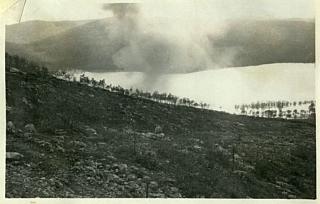
Lago di Doberdò durante un bombardamento
In an atmosphere of patriotic euphoria Italy declared war on the Dual Monarchy on 23 May 1915. Hostilities commenced almost immediately, and on 23 June Italy launched the first offensive by the river Isonzo. The war was primarily conducted in the north east along this river, and in the mountains of Tyrol. Italy enjoyed numerical superiority, and they repeatedly tried to break through the front by Isonzo. Although they carried the war onto Austrian territory, the gain was minimal and at a high cost. Gorizia fell in August 1916 but no decisive victory was ever achieved. A total of 11 battles were fought by Isonzo between June 1915 and October 1917.
In Tyrol the Austrians launched an offensive in May 1916 and enjoyed some progress in the beginning, but after a few weeks they had to give up, not least because of the critical situation in the east during the initial stage of the Brusilov offensive, launched 4 June 1916, threatened Austria-Hungary with a collapse.
The war at sea in Mediterranean Sea has not been given much attention, but here Italy faced the fleet of Austria-Hungary, and after the declaration of war against Germany on 28 August 1915, also German submarines. Italy was also formally at war with Turkey from 21 August 1915 and Bulgaria from 19 October 1915.
Disaster at Caporetto
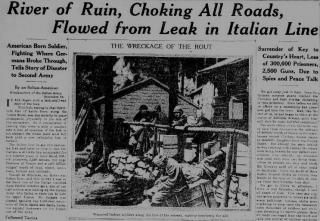
, 6.1.1918
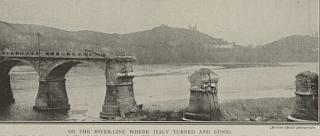
, volume 11
Major changes to the war situation only occurred during the 12th Isonzo battle in October 1917. K.u.k. Heer had now been able to transfer troops from the eastern front after Russia's collapse, and had also been reinforced with German units. The Central Powers launched a surprise attack by Caporetto (sl. Kobarid) on 24 October 1917 and the Italian front broke down already the same day.
The Italian army lost two thirds of its artillery during the chaotic retreat and the 2nd Army was destroyed. Still by mid November the Italians had managed to regroup and stabilize the front by Piave. The losses were frightening: an estimated 300,000 men, the vast majority of these taken prisoner.
The military leadership was subsequently replaced: the ruthless and unpopular commander in chief Luigi Cadorna was succeeded by Armando Diaz and army reforms followed. Discipline in the Italian army during Cadorna's reign was extremely harsh. Approximately every seventeenth soldier was subjected to disciplinary trials, most of tehm were convicted, and around 750 were executed. These numbers are much higher than those of the other armies at war.
In addition Cadorna's inflexible tactics, with frontal assaults, was often blamed for the enormous casualties the Italian army suffered. He also had serious problems co-operating with his fellow generals.
Allied support
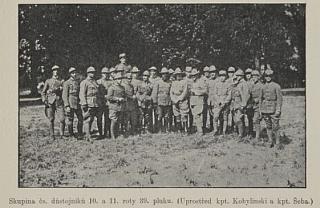
Czechoslovak legionnaires in 1918
From 1917 Italy received considerable support from their allies, both with supplies and manpower. The largest foreign force was British, followed by the French. American troops also took part, but to a minor degree.
Like in Russia and France military units of Czech and Slovak volunteers were formed also in Italy. Here the legions were however formed much later (1918) than in the two other countries, although Czechs fought in the Italian army even before that. Their numbers eventually reached 15,000 and in June 1918 they were used at the Piave front.
End of the war
15 June 1918 k.u.k. Wehrmacht launched another offensive by Piave, now without German help. The attack was unsuccessful and from now on the Italian army enjoyed the upper hand. The decisive offensive however started as late as 24 October 1918, but within days it caused the total collapse of the Austro-Hungarian army. The armistice was signed 3 November 1918 in Villa Giusti, at a time when the Dual Monarchy for all practical purpose had ceased to exist.
The Versailles Treaty
As part of the peace settlement Italy was handed former Austrian territory in Tyrol and on the Istria peninsula (the latter was ceded to Yugoslavia after the Second World War).
This was less than what was promised in the Treaty of London, as the newly established Kingdom of Serbs, Croats and Slovenes (from 1929 Yugoslavia) were handed areas that originally had been promised Italy. The areas in question were primarily those along the coast of Dalmatia.
In Italy the reaction to the peace treaty was negative. Close to half a million Italians had perished during the war, and the gain was only slightly more than Austria-Hungary in 1915 had offered in exchange for neutrality.
IR. 91 in Italy

The journey from Russia to Italy, extract from the diary of Rudolf Kießwetter , 17 November 1915. That day the 91st regiment stopped in Kraków, Oderberg (Bohumín) and Přerov.
© ÖStA
In mid November 1915 Jaroslav Hašek's Infanterieregiment Nr. 91 was transferred from the Volhynia province in Russia (now Ukraine) to the front in Italy. The timing of the author's capture on 24 September 1915 is therefore very important in the light of what direction his fate (and therefore The Good Soldier Švejk) could have taken...
The 2nd, 3rd and 4th battalion of regiment[1] reached the front by Isonzo on 19 November 1915. They ended their train journey at Prosecco by Trieste, and from there they marched north to the front section by Monfalcone. Here their position was on the so-called Karst Plateau on the current border between Italy and Slovenia. They were involved in the fighting already during the 4th Isonzo battle that now was ongoing. Places that often occur in connection with IR. 91 are Doberdò og Jamino, now slightly inside Italian territory, then on Austrian soil.
1. The detached first battalion didn't fight with the rest of the regiment until October 1916, but had arrived at the Isonzo front already before the other three battalions. Funeral by Prosecco, 1917. Fond Jan Ev. Eybl. © SOkA Beroun. Map that roughly shows the movement of IR. 91 on the Italian front from 19 November 1915 until 30 September 1918. Based on "Jednadevadesátníci" (Jan Ciglbauer, 2018).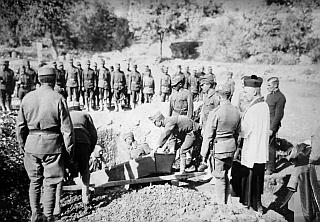
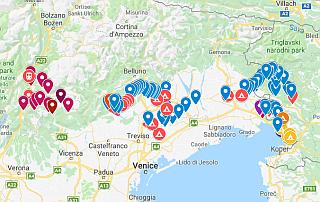
In May 1916 Austria-Hungary launched an offensive in Tyrol and in this context IR. 91 was on 24 May 1916 transported to that front section. They were deployed in the mountains south-east of Trento, but were not involved in any fighting. When the offensive was called off in June, the regiment was transferred back to their original position.
Thus the regiment from 1 July 1916 were again in position east of Monfalcone. They suffered grave losses during the six offensives that Italy launched during the next 15 months, but k.u.k. Wehrmacht held the line despite facing an enemy that was superior in manpower, equipment and ammunition. The regiment now included an elite unit of assault troops that caused a lot of damage in the enemy lines. These were commanded by captain Peregrin Baudisch, an officer that had distinguished himself already during the battle by Sokal in 1915. The 10th Isonzo-battle was particularly fierce and on 26 May 1917 all four battalions of IR. 91 distinguished themselves during the battle. The regiment had by now established a reputation as a formidable fighting force, and the enemy referred to them as the "green devils".
18 September 1917 they were transferred north to the front section by Gorizia where they took part in the 11th Isonzo battle by Monte San Gabriele (sl. Škabrijel).
After the break-through of the Central Powers by Caporetto 24 October 1917, IR. 91 joined the advance on the Piave. Three days later they crossed the Isonzo for the first time, and 30 October 1917 they found themselves on Italian soil. The civilian population had already fled, and the regiment came across huge amounts of provisions and equipment that the Italians had left behind during the retreat. Piave was reached 13 November 1917 and the area by the river would be their area of operation for the next 11 months.
From around Christmas 1917 until June 1918 the regiment held a sector of the front by Valdobbiadene, an area where Piave flows down from the mountains and onto the low plain. Here they for the first time faced French and British units, and also came in contact with Czech legionnaires. By Piave, 15 June 1918. Bestand Rudolf Kießwetter. © ÖStA
In this period the casualties caused by direct enemy fire were negligible, but another enemy caused serious decimation of the ranks: hunger and disease. Austria-Hungary now had 300 000 extra Italian prisoners to feed, and the effects of the Allied blockade was felt more and more. In the so far reliable IR. 91 there were now signs of open discontent, and the will to fight spiralled downwards. The Italian supplies that were captured in the wake of Caporetto were already exhausted.
On 15 June 1918 k.u.k. Heer launched a failed offensive by Piave, now with IR. 91 in the reserve. Through the summer the regiment guarded the front section by Grave di Papadopli, a large island in Piave, some distance south of Valdobbiadene. After the Bulgarian capitulation the entire 9. Infanteriedivision was transferred to the front in southern Serbia (see Niš). The departure from Piave took place on 30 September 1918.
Švejk and Italy

Dobrý voják Švejk a jiné podivné historky, 1912.
The first version of The Good Soldier Švejk, five short stories from 1911 has much more focus on Italy than the novel has. The first story, printed in Karikatury 22 May 1911 is even titled Švejk stands against Italy. Here the good soldier strays across the border near Trento and captures a mule and an Italian machine gun.
In these stories Švejk was posted at the garrison in Trento, at the time a huge fortress complex that guarded Austria's southern border against Italy. Still the plot almost exclusively takes place on the Austrian side of the border, the exception being the aforementioned episode with the mule and the machine gun.
Another Austrian border fortress features in the play Pevnost, co-written by Hašek, and was performed around the time the first stories about Švejk appeared. This play is set in Monfalcone near the mouth of the river Isonzo. Ironically this was the area where Jaroslav Hašek's own IR. 91 (now without the author) were to fight and suffer from the end of 1915 until the autumn of 1917.
Some of the prototypes of characters in The Good Soldier Švejk also took part in the campaign against Italy: Jan Vaněk, Rudolf Lukas, Čeněk Sagner, Jan Eybl, Franz Wenzel, and Hans Bigler. The latter is the only one that appears to have stayed at the front until the capitulation. A more peripheral name is Oberleutnant Wurm, from 1 July 1915 captain. In his diary Václav Čertík remembers that Wurm shot down an Italian plane on 8 January 1916.
Quote(s) from the novel
[I.14.5] Ještě posíláme chmel do Italie, ale obávám se, že se Italie také do toho zamíchá.
[I.14.5] "Itálie zachovává přísnou neutralitu," těšil ho nadporučík, "to je..."
Credit: Rudolf Kießwetter, Jan Ev. Eybl, Jan Ciglbauer
Also written:ItálieczItaliendeItaliait
Literature
- Cronologia della Guerra al fronte italiano,
- Fronte del Piave,
- Trippelallianse,
- Il popolo d'Italia,
- Documenti e immagini della grande guerra,
- Trattati della Triplice alleanza (1882-1912),
- Die Unterzeichnung des Vertrages in Wien, ,10.12.1912
- 100 let od vypuknutí bojů mezi Rakušany a Italy,
- Válka s Itálií a co jí předcházelo,
- Průběh 1. světové války v Itálii (1915-1918),
- Švejk stojí proto Itálii, ,1912
- Časová osa IR91,
- Haškovy Osudy dobrého vojáka Švejka v italských překladech, ,2021
 | Meuse |  | ||||
| ||||||

Meuse along the map to the left

,3.4.1915
Meuse is mentioned by hop trader Wendler when the laments the state of the hop trade. He wonders why there is still artillery fights between Meuse and Moselle now when the war allegedly is going so well.
Background
Meuse is a river that flows from France, through Belgium and the Netherlands before emtying into the North Sea. The total length is 925 km.
From 1914 to 1918 the battlefront was close to Meuse in the area around Verdun. The fighting mentioned by hop trader Wendler took place in early April 1915 and was reported in official announcements from Berlin on 2 April. The author employs these quotes almost exactly as they were printed in Czech newspapers.
Changed spelling
Sergey Soloukh points at that in current issues of the novel the spelling is Maasa and not Mosa that the author used. Why the correct spelling was changed later is baffling. Mosa was the official Czech name in 1921 and was also the term found in the press snippets that the author obviously used[a]. Moreover Mosa is perfectlyy valid also today (2019), although Máza is more common.
Quote(s) from the novel
[I.14.5] Proč zas se vedou mezi Mosou a Moselou prudké dělostřelecké boje?
Credit: Sergey Soloukh
Also written:Máza/MosaczMaasnl
Literature
| a | Kronika světové války |
 | Woëvre |  | ||||
| ||||||


,4.4.1915
Woëvre is one of the many places mentioned in hop trader Wendler's frustrated tirade regarding the hop-trade. Three breweries in the area is said to have burnt down.
Background
Woëvre is a region in Lorraine in nort eastern France. It is located near Metz and the famous battlefield by Verdun. The front passed through here for almost the full length of the war and the events hop trader Wendler somewhat imprecisely refers seem to be taken from a news release issued by the German HQ on 28 March 1915. These news bulletins appeared on the front page of newspapers in Austria-Hungary throughout the war.
In Národní politika from 4 April Woëvre is mentioned again in a summary of events from the previous week. Now it is in a wording very close to what appears in the novel, but in all the press reports there is talk of the Woëvre plain, so hop trader Wendler is slightly imprecise.
Großes Hauptquartier, 28. März. Westlicher Kriegsschauplatz
Südöstlich von Verdun wurden französische Angriffe auf den Maashöhen bei Combres und in der Woevre-Ebene bei Marcheville nach hartnäckigen Kämpfen zu unseren Gunsten entschieden.
Quote(s) from the novel
[I.14.5] Víte, že v Combres a Woewru u Marche shořely tři pivovary, kam jsem posílal ročně přes pět set žoků chmele?
Also written:WoevreHašekWaberlandde
Literature
 | Combres |  | ||||
| ||||||
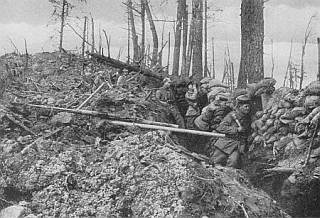

,4.4.1915

Mapire.eu (1836)
Combres is mentioned in hop trader Wendler tale of woe about the hop-trade. Three breweries in the area is said to have burnt down.
Background
Combres (officially Combres-sous-les-Côtes) is a municipality in the Meuse-department in Lorraine in France. It is located east of Verdun and was on or near the front almost the entire war.
In late March and early April 1915 fierce battles took place here, and it looks very much as if the author has used a news bulletin from 28 March in this sequence, repeated in Národní politika in a news summary on 4 April 1915 and not the least Kronika světové války.
Großes Hauptquartier, 28. März. Westlicher Kriegsschauplatz
Südöstlich von Verdun wurden französische Angriffe auf den Maashöhen bei Combres und in der Woevre-Ebene bei Marcheville nach hartnäckigen Kämpfen zu unseren Gunsten entschieden.
Quote(s) from the novel
[I.14.5] Proč zas se vedou mezi Maasou a Moselou prudké dělostřelecké boje? Víte, že v Combres a Woewru u Marche shořely tři pivovary, kam jsem posílal ročně přes pět set žoků chmele? A shořel i ve Vogesách Hartmansweilerský pivovar, je srovnán se zemí ohromný pivovar v Niederspachu u Mylhúz.
Literature
 | Marche |  | ||||
| ||||||
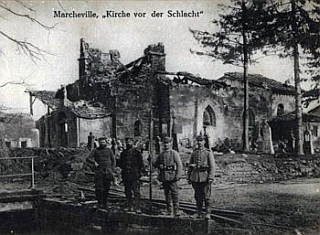

,29.3.1915

, s. 506
Marche is one of the many places hop trader Wendler mentions in his lament on the declining hop-trade. He simply calls it Marche, but the news bulletins reveal that he means Marchéville. There were three breweries in the area that were burnt down. Before the war Wendler had supplied them with hops, but now the trade was in tatters.
Background
Marche no doubt refers to Marchéville (officially Marchéville-en-Woëvre), a village in Lorraine in France. It is located not far from Verdun and in 2015 it counted a mere 76 citizens.
The fighting referred to was reported by German HQ on 28 March 1915, and their bulletin is partly (and imprecisely) reproduced by hop trader Wendler.
Cut, paste and add breweries
Marchéville is one of a number of place names on the Western Front that find its way into world literature through hop trader Wendler's long monologue of misery in front of Oberleutnant Lukáš. The names are all copied from Kronika světové války, and this publication is beyond doubt the source the author used when he composed the conversation between the hop trader and the officer.
That all these places hosted a brewery can by near certainty ruled out. Some of them were small villages, and in one case only a farm (Klosterhoek). That the small area east of Verdun had three breweries is almost inconceivable.
Similar information was however available from a number of newspapers, but Kronika světové války is the only known case where the wording (including spelling mistakes) corresponds literally to the words of hop trader Wendler and Oberleutnant Lukáš. This is particularly striking in the words of Lukáš (see Cevat Paşa, Halil Bey etc.).
Sergey Soloukh points out that the hyphen of Marchéville, as it is printed in Kronika světové války, may be the reason why the author called the place only Marche and his hypothesis is entirely plausible.
Quote(s) from the novel
[I.14.5] Víte, že v Combres a Woewru u Marche shořely tři pivovary, kam jsem posílal ročně přes pět set žoků chmele?
Credit: Sergey Soloukh
Literature
 | Vosges |  | ||||
| ||||||

,23.12.1915

,4.4.1915
Vosges was yet another place where hop trader Wendler's lost his market for hops. The brewery in Hartmannsweiler burnt down and the giant one in Niederaspach was razed to the ground.
Background
Vosges is a mountain range in north eastern France that between 1871 and 1918 straddled the French-German border. During World War I the front stretched along the mountains and in late March and early April 1915 there was heavy fighting here, events that the author transforms into destruction of breweries. Whether these breweries were destroyed (or even existed) has yet to be confirmed.
Quote(s) from the novel
[I.14.5] A shořel i ve Vogesách Hartmansweilerský pivovar, je srovnán se zemí ohromný pivovar v Niederaspachu u Mylhúz.
Also written:VogézyczVogesendeLes Vosgesfr
Literature
 | Hartmannsweiler |  | ||||
| ||||||
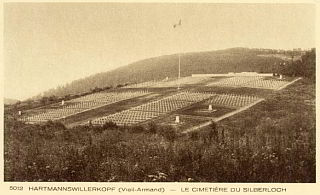

,4.4.1915
Hartmannsweiler also had a brewery that hop trader Wendler traded with back in the good old days. This was before it was burnt down during the fighting.
Background
Hartmannsweiler is the German name of Hartmannswiller, a small place in Alsace on the eastern slopes of the Vosges, north west of the regional capital Mulhouse. Like the rest of the region it was part of Germany from 1871 to 1918.
It was the scene of fierce fighting during World War I, particularly in 1915. The battles mainly concerned Hartmannsweilerkopf, a summit of 956 metres west of the village. Today there is a large war cemetery and a French national monument. The village itself was destroyed by artillery bombardments.
As with the other Belgian and French breweries mentioned by hop trader Wendler in the conversation with Oberleutnant Lukáš the brewery here is presumably an invention. It may of course have existed, but even in this is the case it is unlikely that the author had any knowledge of it.
Quote(s) from the novel
[I.14.5] A shořel i ve Vogesách Hartmansweilerský pivovar, je srovnán se zemí ohromný pivovar v Niederspachu u Mylhúz.
Also written:HartmansweilerHašekHartmannswillerfr
Literature
 | Niederaspach |  | ||||
| ||||||
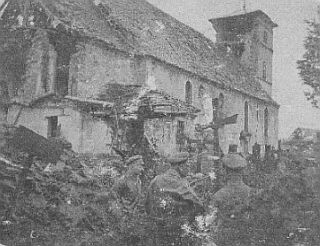

, s. 507
Niederaspach was another place with a destroyed brewery. This enormous brewery had, according to hop trader Wendler, been razed to the ground
Background
Niederaspach is the German name of Aspach-le-Bas, a municipality in the Haut-Rhin departmentet in Alsace, from 1871 to 1918 part of Germany. It is located west of the regional capital Mulhouse.
It has not been possible to verify the existence of any brewery here, and certainly not a gigantic one (as hop trader Wendler claims).
The front stretched through the area through most of the war. In November 1914 it was frequently mentioned in German Kriegsberichte and it also appeared in April 1915.
The World war Chronicle
Niederaspach appears in war bulletins in early April 1915, and not the least in Kronika světové války, a publication that Hašek no doubt made use of when he composed the conversation between Oberleutnant Lukáš og hop trader Wendler.
Großes Hauptquartier, 3. April.
Ein französischer Angriff auf die Höhen bei und südlich von Nieder-Aspach westlich von Mülhausen wurde zurückgeschlagen.
Quote(s) from the novel
[I.14.5] A shořel i ve Vogesách Hartmansweilerský pivovar, je srovnán se zemí ohromný pivovar v Niederaspachu u Mylhúz.
Also written:Aspach-le-Basfr
Literature
 | Mühlhausen |  | ||||
| ||||||
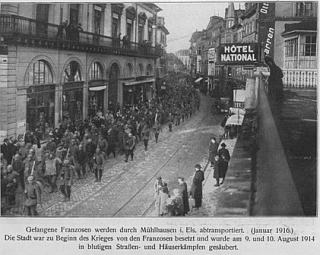

,11.4.1915
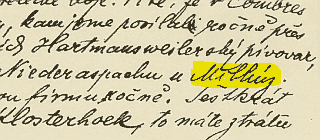
Dobrý voják Švejk (Rukopis) (s. 156)
© LA-PNP
Mühlhausen is named in the tirade from hop trader Wendler about the failing demand for hops. He mentions a brewery in Niederaspach by Mylhúzy, the Czech name of the city.
Background
Mühlhausen is the German name of Mulhouse, a city in the province of Alsace (ge. Elsass) near the border of Switzerland and Germany. As the rest of Alsace it was part of Germany from 1871 to 1918.
Changed spelling
Current issues of the novel write Mylhúz and not Milhúz as the author used and the press reports used at the time. That change was introduced as part of a language "clean-up" of the novel that took place soon after 1950.
Kámen mudrců
One of Jaroslav Hašek's pre-war stories is set in Mulhouse[a].
Großes Hauptquartier, 3. April.
Ein Versuch der Belgier, das ihnen am 31. März entrissene Klosterhoek-Gehöft wieder zu nehmen, scheiterte. Im Priesterwalde mißlang ein französischer Vorstoß. Ein französischer Angriff auf die Höhen bei und südlich von Nieder-Aspach westlich von Mülhausen wurde zurückgeschlagen.
Quote(s) from the novel
[I.14.5] A shořel i ve Vogesách Hartmansweilerský pivovar, je srovnán se zemí ohromný pivovar v Niederspachu u Mylhúz.
Also written:MylhúzyczMulhousefr
Literature
- Kronika světové války,
- Kámen mudrců, Jaroslav Hašek,18.6.1911 [a]
| a | Kámen mudrců | Jaroslav Hašek | 18.6.1911 |
 | Klosterhoek |  | ||||
| ||||||
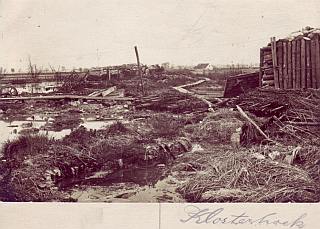
© Herman Declerck
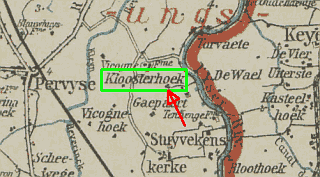
, 1917

Kronika světové války, 2.4.1915
, s. 507
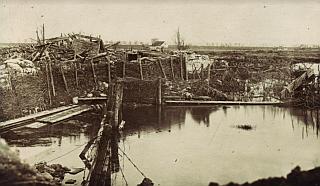
© Herman Declerck
Klosterhoek had according to hop trader Wendler hosted a brewery which had been fought over six times between German and Belgian forces. Because of this he had an annual loss of 350 sacks of hops. The conversation took place on 20 December 1914.
Background
Klosterhoek (also Kloosterhoek) was a farm east of Pervijze in Flanders, by Stuivekenskerke slightly west of the river Ijzer (Yser). Heavy fighting took place here in October 1914 and in March/April 1915 and it is also mentioned in news items from 1916 and 1917.
In the front line
German forces reached the river Ijzer (Yser) late in October 1914 where they crossed the river and occupied Klosterhoek a.o. Some days later the Belgians opened the ditches causing the area to be flooded and the Germans withdrew. The next news came from German official bullrtins that reported that they on 31 March 1915 had occupied the farm. On 2 April the Belgians failed in an attempt to recapture it and the stalemate by Yser lasted until the end of the war. The area was bombarded to the ground, and towns like Pervijze, Diksmuide and Veurne were ravaged. Klosterhoek itself was never rebuilt and today the site of the previous farm is a field.
The World War Chronicle
An analysis of the historical events that hop trader Wendler refers to during the conversation indicate that the fighting in question took place early in April 1915, despite the author having the conversation between him and Oberleutnant Lukáš taking place 20 December 1914!
Klosterhoek appears in war bulletins in early April 1915, and not the least in Kronika světové války (The World War Chronice), a publication that Hašek no doubt made use of when he composed the conversation between Oberleutnant Lukáš and hop trader Wendler. It seems safe to assume that Hašek picked the geographical names from these bulletins but allowed himself to add the breweries (see Marchéville).
No brewery
Local historian Herman Declerck reveals that before World War I there were six breweries in Pervijze, but none of them were located by Klosterhoek, this was simply the name of the farm.
Quote(s) from the novel
[I.14.5] Proč zas se vedou mezi Maasou a Moselou prudké dělostřelecké boje? Víte, že v Combres a Woewru u Marche shořely tři pivovary, kam jsem posílal ročně přes pět set žoků chmele? A shořel i ve Vogesách Hartmansweilerský pivovar, je srovnán se zemí ohromný pivovar v Niederspachu u Mylhúz. To máte ztráty 1200 žoků chmele pro mou firmu ročně. Šestkrát bojovali Němci s Belgičany o pivovar Klosterhoek, to máte ztrátu 350 žoků chmele ročně.“
Credit: Herman Declerck, Jaroslav Šerák
Literature
- Vijandige vergezichten,
- The Belgian Sector Part Nine – Stuivekenskerke, ,20.3.2015
- Pervijze sporen oorlogsverleden,
- Le communiqué Alemand, ,3.4.1915
- Communiqué Belge, ,29.5.1917
 | Zagreb |  | |||
| |||||
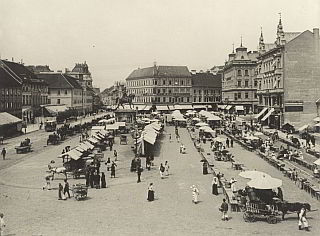
Zpor_Por. Jelacic-Platz in Agram, Österreich-Ungarn (heute: Zagreb, Kroatien) (1909).
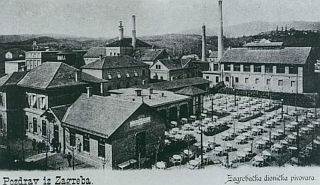
Zagreb was another place to which hop trader Wendler had to go to look for his wayward spouse. This trip he used well as he struck a deal with the municipal brewery, selling them 600 sacks of hops. This market was unfortunately lost by the end of 1914.
hop trader Wendler's trip to Zagreb must have taken place in 1913 as he states the this was "last year" and the author informs that the plot in these seqience of the novel takes place in December 1914.
Background
Zagreb was in 1914 capital of the Hungarian ruled autonomous Kingdom of Croatia-Slavonia. At the time it was also known through it's German name Agram, a term that is rarely used anymore. Zagreb is now the capital of the republic of Croatia.
Breweries
The city presumably hosted several brwereies, but it is not known whether any of them were owned by the council. The largest of them was not doubt Aktienbrauerei und Malzfabrik in Agram, locally simply called Pivovara, that in 1910 was the 6th largest brewery in the entire Austria-Hungary. Beer production this year totalled 26,226 hectolitres.
This large brewery was founded as a joint limited company in 1893 through a merger of several smaller breweries who were unable to expand on their original sites. It still exists in 2019 and is known as Zagrebačka pivovara. The current owner is Molson Coors Brewing Company.
Military
Per the recruitment districts, infantrymen from Zagreb were usually assigned to Infanterieregiment Nr. 53 (Agram) or Honvédinfanterieregiment Nr. 25 (Agram).
Quote(s) from the novel
[I.14.5] A když odešla se obléknout, tiše řekl k nadporučíkovi: „Nevyvádí to ponejprv. Loni ujela s jedním suplentem a našel jsem je až v Záhřebu. Udělal jsem při té příležitosti v městském pivovaře v Záhřebě uzávěrku na žoků chmele.
Also written:ZáhřebczAgramdeZágrábhu
Literature
 | Warsaw |  | |||
| |||||
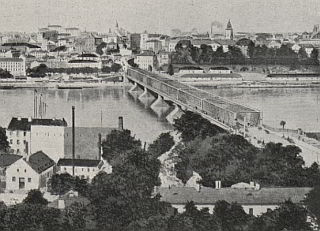
,16.10.1914

The brewery around 1900
© Warsaw on postcards

,1.10.1891
Warsaw is mentioned 4 times in The Good Soldier Švejk.
Warsaw was another hop market that was lost for hop trader Wendler and he adds that the Augustian Brewery was the largest in the city. The representative for the brewery even visited Wendler each year.
Background
Warsaw is since 1918 capital of Poland and the biggest city in the country. It is located by the river Vistula.
The city was in 1914 capital of the Kingdom of Poland (or Congress Poland), until 1915 a Russian satelltite state. During the autumn of 1914 the Germans made several failed attempts to conquer the city. Warsaw finally fell on 4 August 1915 and remained on German hands for the rest of the war.
Breweries
It has not been possible to identify any Augustian brewery in the city. The largest brewery in Warsaw at the end of the 19th century was Haberbusch i Schiele (ru. Габербуш и Шиле), a position it held also in 1914. The company also operated their own bottling plant in Kiev. The company retained its leading position in the inter-war independent Poland, but was destroyed during the Warsaw uprising in 1944. Other breweries in the city were Machlejd and Livonia. Warsaw was also an important centre for hop trading in the Russian Empire, and in this context it was often mentioned in specialist publications in Austria.
Other possibilities
There is also a possibility that hop trader Wendler exported hops to an overseas brewery. There are several towns named Warsaw in the United States, and there was a brewery in, for instance, Warsaw, Illinois. This brewery was however not called "Augustinian", and the idea that Wendler has anywhere but the Polish city in mind appears remote.
The brewery name is rather a mix-up with the famous Augustiner-Bräu in Munich or one of the other Augustiner breweries that existed at the time (Salzburg, Wittenberg ...), although not even in Munich this was the largest brewery.
Quote(s) from the novel
[I.14.5] A zapaluje si nabídnutou cigaretu, řekl zoufale: „Jedině Varšava odebírala 2370 žoků chmele. Největší pivovar je tam augustiánský. Zástupce býval u mně na návštěvě každoročně. To je k zoufání. Ještě dobře, že nemám děti.“
[I.14.5] Tento logický závěr každoroční návštěvy zástupce augustiánského pivovaru z Varšavy způsobil, že se nadporučík jemně usmál, což obchodník s chmelem postřehl, a proto vykládal dál: ....
Also written:VaršavaczWarschaude
Literature
- en.wikipedia.org/wiki/Haberbusch_i_Schiele,
- Hopfenhandel in Polen, ,1.12.1902
- První chmelařská akc. společnost ve Varšavě, ,1.12.1908
 | Sopron |  | ||||
| ||||||
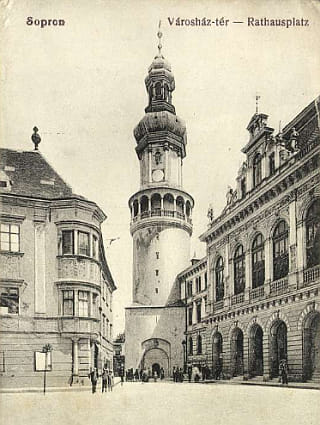

,1.4.1900

,5.1.1907
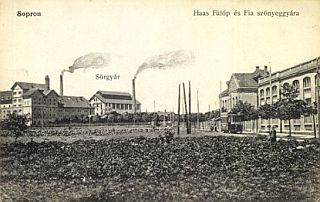
The brewery in Sopron
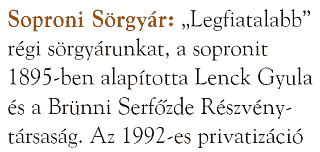
Magyar Sörlexikon
Sopron and its brewery troubled hop trader Wendler with poor demand after the outbreak of war. The brewery had until then exported its beer all the way to Alexandria.
When the plot later moves to Királyhida the city is mentioned in several contexts, and also indirectly through Sopronyi utcza and the newspaper Sopronyi Napló. Sopron was also the birthplace of Etelka Kakonyi.
Background
Sopron is a city in Hungary near the Austrian border, regarded as the country's oldest city. It is located 5 km south-west of Neusiedler See.
In 1910 the population count was 33,932 and amongst these the Germans were just about the largest ethnic group. The city was (and is) connect by rail to, amongst others, Győr and Wiener Neustadt. Sopron was after the peace treaty of Trianon in 1920 to join Austria, but a referendum overturned the decision so it remained in Hungary. Today Sopron has more than 60,000 inhabitants.
The brewery
The brewery was established as a limited company on 30 March 1895 by factory owner Julius Lenck and a beer consortium from Brno. At the start the capacity was 25,000 hectolitres per year. The official name was Első Soproni Serfőzde és Malátagyár Részvénytársaság, in German Erste Oedenburger Bierbrauerei- und Malzfabrik-Aktiengesellschaft. The brewery existed under this name until 1917 when it was bought by a larger Hungarian enterprise. The brewery is still operating (2019) and is owned by Heineken.
Hašek in Sopron
Jaroslav Hašek visited Sopron in 1905 together with Jaroslav Kubín and František Wágner. This was part of a longer trip that later was described in some detail in Strana mírného pokroku v mezích zákona, and also well covered by Václav Menger. According to Václav Menger they stayed with the brewmaster in Sopron, a Czech.
Demography
According to the 1910 census Sopron had 33 932 inhabitants. The judicial district was Sopron, administratively it reported to vármegye Sopron.
Military
Per the recruitment districts, infantrymen from Sopron were usually assigned to Infanterieregiment Nr. 76 (Sopron) or Honvédinfanterieregiment Nr. 18 (Sopron).
Nagykanidžská idyla
Velice důležitým poznatkem na naší cestě ze Šoproně do Velké Kanidže, kde se nejdéle udržel pašalík turecký, bylo, že nejspokojenější lidé jsou právě ti, kterým násilím nebyla vnucena vzdělanost.
Quote(s) from the novel
[I.14.5] „Uherské pivovary v Šoproni a ve Velké Kaniži odbíraly pro svá exportní piva, která vyvážely až do Alexandrie, u mé firmy ročně průměrem 1000 žoků chmele.
[II.3] Od opuštěného pavilónku, kde dřív za času míru fotografoval nějaký fotograf vojáky trávící zde mládí na vojenské střelnici, bylo vidět dole v údolí u Litavy červené elektrické světlo v bordelu „U kukuřičného klasu“, který poctil svou návštěvou arcivévoda Štěpán při velkých manévrech u Šoproně v roce 1908 a kde se scházela denně důstojnická společnost.
[II.3] „A bydlí s paní Etelkou v prvním patře,“ řekla garderobiérka s podrobností staré kuplířky, „ona je Němkyně ze Šoproně a on je Maďar; zde je to všechno pomíchané.“
[II.5] A vedl je sám pan hejtman Ságner. Byly by snad přišly až do Šoproně, kdyby se nebylo rozednilo,“ pokračoval tajemným hlasem účetní šikovatel, který si liboval v takových případech a měl v evidenci všechny podobné události.
Credit: Václav Menger, Radko Pytlík, Csaba Catona
Also written:ŠoproňczÖdenburgde
Literature
- Nagykanidžská idyla,
- Lidský profil Jaroslava Haška, ,1946
- Šoproň,
- History of the Sopron brewery,
- Soproni,
- Magyar Sörlexikon,
- Julius Lenck,
- History,
- Prospekt, ,13.3.1895
- Oedenburg, ,31.3.1895
- Statistik des In- und Auslandes, ,15.10.1896
 | Nagykanizsa |  | ||||
| ||||||
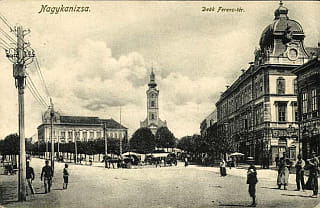
Nagykanizsa, 20.8.1911

,15.10.1892

Kataliszt blogja

,15.5.1905
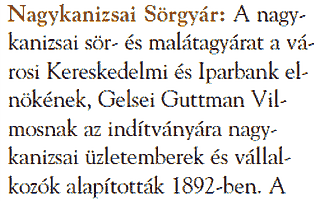
Magyar Sörlexikon
Nagykanizsa and the city's brewery provided hop trader Wendler with good demand for hops until war turned the trade upside-down. The brewery bought an annual average of 100 sacks of hops from him and exported their beer all the way to Alexandria.
Background
Nagykanizsa is a city in the Zala county in Hungary, located appx. 40 km south-west of Lake Balaton and 15 km from the border with Croatia.
Hašek visiting
Jaroslav Hašek visited the city in 1905 and later wrote a couple of stories set there, and many more that mentions the city. In Strana mírného pokroku v mezích zákona he recalls being welcomed by the Czech brew-master there, a certain Mr. Znojemský.
The brewery
The brewery was established in 1892 and operated until 1999. It was in the years before World War I a medium-size brewery with an output of 47,000 hectolitres in 1912. The company's official name was Nagy-Kanizsai Serfőzde és Malátagyár Részvénytársaság, in German Nagy-Kanizsaer Bierbrauerei- und Malzfabrik-Aktiengesellschaft.
In 1902 Jan Znojemský became brewmaster at the plant. This is without doubt the person Hašek refers to in his story as Znojemský was still there in 1905. In 1909 he assumed the same role at the brewery F.F. Bote in Jekaterinoslav in Russia (now Dnipro, Ukraine), but resigned shortly after the outbreak of war.
Spelling
An added curiosity is that a number of translations struggle with the spelling of Nagykanizsa. Amongst them are the first German, the Norwegian, the latest Swedish and all three English. The latest Dutch, Finnish and German translations however spell the name correctly. The error is however difficult to spot: the letters "s" and "z" are swapped.
It should be noted that this error appeared quite frequently in the newspapers of the period, and even in official publications. Previously the name was written with a hyphen as Nagy-Kanizsa, similar to, say, Király-Hida.
Demography
According to the 1910 census Nagykanizsa had 26 524 inhabitants. The judicial district was Nagykanizsa, administratively it reported to vármegye Zala.
Military
Per the recruitment districts, infantrymen from Nagykanizsa were usually assigned to Infanterieregiment Nr. 48 (Nagykanizsa) or Honvédinfanterieregiment Nr. 20 (Nagykanizsa).
Quote(s) from the novel
[I.14.5] „Uherské pivovary v Šoproni a ve Velké Kaniži odbíraly pro svá exportní piva, která vyvážely až do Alexandrie, u mé firmy ročně průměrem 1000 žoků chmele.
Credit: Václav Menger, Radko Pytlík
Also written:Velká KanižaczGroßkirchen/Groß-Kanizsade
Literature
- Jaroslav Hašek doma, ,1935
- Přísaha Michy Gama, Jaroslav Hašek,3.4.1909
- Přísaha Michy Gama (Pokrač.), Jaroslav Hašek,17.4.1909
- Přísaha Michy Gama (Dokončení.), Jaroslav Hašek,1.5.1909
- Život na Puszta Magyarádě, Jaroslav Hašek,29.10.1909
- Maďarské moře, Jaroslav Hašek,20.8.1910
- Velká Kanidža a Körment, Jaroslav Hašek,26.4.1913
- Láska v Mezimuří, Jaroslav Hašek,20.12.1913
- Běh o závod, Jaroslav Hašek,18.5.1921
- Rozjímání o počátku cesty, většinou necestopisné, Jaroslav Hašek,9.1926
- Nagykanidžská idyla,
- Pokračování idyly Nagykanidžské,
- Nagykanizsai Sörgyár Rt.,
- Magyar Sörlexikon,
- Personalien, ,15.9.1902
- Osobní z kruhů pivovarnických, ,18.9.1902
- Biererzeuging Österreich-Ungarns im Jahre 1910, ,1.6.1911
 | Alexandria |  | |||
| |||||
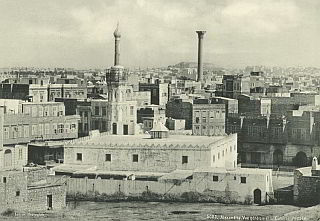
Alexandria 1875
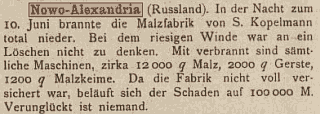
,27.6.1911
Alexandria was a city that enjoyed beer imported from Hungary, brewed with hops delivered by hop trader Wendler.
Background
Alexandria (arab. الإسكندرية) is a city in Egypt, named after Alexander the Great, the city's founder. In ancient times it was known for its library and its light-house, both classed amongst the seven wonders of the world.
In 1914 Egypt was formally still part of Turkey but had been occupied by the British since 1882. At the outbreak of war in 1914 the country was made a British protectorate, which no doubt ended any beer import from Austria-Hungary that ever was.
Reports from 1903 reveal that beer products were exported to Alexandria and other harbours in the Mediterranean Sea via Trieste.
Alternatives?
There are a number of places named Alexandria around the world so one can't be one hundred per cent certain that hop trader Wendler actually had the Egyptian city in mind. Beer was already exported overseas and the numerous Alexandrias in North America are possible candidates.
Closer to home there is a remote possibility that hop trader Wendler was talking about Nowa Alexandria in Russian Poland, sometimes referred to as simply Alexandria. The town is now called Puławy but was from 1846 to 1918 named after tsarina Alexandra Feodorovna (1798-1860).
The Romanian town of Alexandria can likewise not be entirely ruled out, being situated close to the Hungarian border.
Quote(s) from the novel
[I.14.5] „Uherské pivovary v Šoproni a ve Velké Kaniži odbíraly pro svá exportní piva, která vyvážely až do Alexandrie, u mé firmy ročně průměrem 1000 žoků chmele.
Also written:Alexandriecz
Literature
 | Zámecké schody |  | |||||
| |||||||
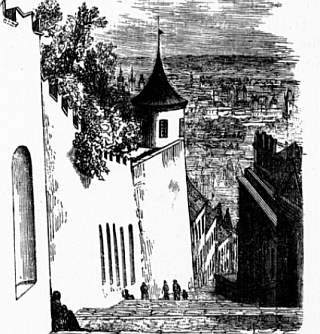
Královský hrad pražský, 1894
Zámecké schody are mentioned as Švejk and Blahník are sitting in a small pub at the lower end of the steps as they plan the infamous dog-theft.
Background
Zámecké schody (Castle Steps) are steps that lead from Prague Castle at Hradčany down Malá Strana. The current appearance has been roughly unchanged since the mid 17th century.
It ends down in Thunovkská ulice and this is where the mentioned small pub must have existed. See Malý výčep piva.
Quote(s) from the novel
[I.14.6] Na Malé Straně u Zámeckých schodů je malý výčep piva. Jednoho dne tam seděli v šeru vzadu dva muži. Jeden voják a druhý civilista. Nakloněni k sobě šeptali si tajemně. Vyhlíželi jako spiklenci z dob Benátské republiky.
Also written:Castle StepsenSlottstrappano
 | Venetian Republic |  | ||||
| ||||||
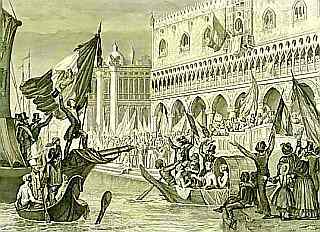

Břetislav Hůla
© LA-PNP
Venetian Republic is mentioned when the two dog thieves, Švejk and Blahník, are compared to conspirators from the time of the Venetian Republic.
Background
Venetian Republic may refer to the city state of Venice that existed for around 1000 years until 1797.
An alternative is Repubblica di San Marco, a short-lived republic that in 1848-49 rose up against Austrian rule. It was centred on Venice and consisted more or less of the current region of Veneto.
The Venetian Republic is also the theme in the story Turista Aratáš[a]. In this case there is however is no doubt that he refers to the classical city state.
Quote(s) from the novel
[I.14.6] Na Malé Straně u Zámeckých schodů je malý výčep piva. Jednoho dne tam seděli v šeru vzadu dva muži. Jeden voják a druhý civilista. Nakloněni k sobě šeptali si tajemně. Vyhlíželi jako spiklenci z dob Benátské republiky.
Also written:Benátská republikaczRepubblica di San Marcoit
Literature
- Turista Aratáš, Jaroslav Hašek,30.4.1911 [a]
| a | Turista Aratáš | Jaroslav Hašek | 30.4.1911 |
 | Klamovka |  | ||||
| ||||||
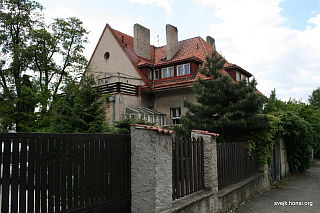
Former "Víla Svět zvířat", 16 May 2011
Klamovka is mentioned by Blahník when he and Švejk are planning the dog-theft in the little pub by Zámecké schody. The place in question is a kennel above Klamovka.
Background
Klamovka is a park area in Košíře and Smíchov, named after the Bohemian noble family Clam-Gallas. The main attraction of the park was (and is) the restaurant with a terrace that at the time often put on concerts with military orchestras. Egon Erwin Kisch has vividly described the ambience at Klamovka in his story Der Clamsche Garten from the collection Aus Prager Gassen und Nächten (1912).
Hašek and Klamovka
Jaroslav Hašek was in 1909 and 1910 editor of the zoological journal Svět zvířat which editorial offices were located in a villa just above the park. The kennel referred to in the novel was in the garden in front of the villa (see Psinec nad Klamovkou). In 2011 the villa was in disrepair and by 2015 it had been demolished.
Jaroslav Hašek was dismissed in the autumn of 1910 after Václav Fuchs (the journal's owner) became dissatsified with his irregular appearances and the office and that readers had started to complain about dubious stories. After the dismissal he and his wife set up their own short-lived Cynological Institute below Klamovka.
Quote(s) from the novel
[I.14.6] Voják s civilistou si ťukli a civilista dále šeptal: „Jednou ode mne jeden černej špic, kterýho jsem potřeboval pro psinec nad Klamovkou, nechtěl taky vzít buřt
Credit: Jaroslav Šerák, Radko Pytlík, Ladislav Hájek
Literature
- Z mých vzpomínek na Jaroslava Haška, ,1925
- Toulavé house, ,1971
- ......a hledal psinec a redakci "Světa zvířat",
- Přátelé zvířat!!, ,25.12.1908
- Má drahá přitelkyně Julča, Jaroslav Hašek,23.4, 30.4, 7.5.1914
- Kynologický ústav, Jaroslav Hašek,17.4, 1.5.1914
- Můj obchod se psy a jiné humoresky, ,1915
- V přírodovědeckém časopise, Jaroslav Hašek,31.7.1911
 | Havlíčkovo náměstí |  | |||||
| |||||||

Havlíčkovo náměstí, around 1910

Český Lloyd, 13.9.1902
Havlíčkovo náměstí (now Senovážné náměstí) was where the unhappy stable pinscher Fox was stolen by Blahník. The theft started right here and the dog was put on a lead in Jindřišská, just a few minutes away. Švejk had earlier been here to verify the eating habits of Fox. He did so by befriending the maid of Oberst Kraus.
Background
Havlíčkovo náměstí (Havlíček square) is the former name of the square Senovážné náměstí in Nové město. The name that appears in the novel was in use from 1896 to 1940 and it has also been named after František Soukup and Maxim Gorky. The square is located north of the main railway station.
Jaroslav Hašek worked for Banka Slavia here for a short while in 1902 and 1903 until he was dismissed after two absences without leave.
Name changes
This square should not be confused with the current Havlíčkovo náměstí in Žižkov, a square that in 1914 was called Basilejské náměstí (Basel Square).
The Good Soldier Švejk in Captivity
In Dobrý voják Švejk v zajetí the square is also mentioned but the context is different. The author expresses disgust with the fact that the German consulate is located on a square named after the Czech national hero Karel Havlíček.[1]
Mladý úředník od berního ředitelství hlasitě se smál. Byl zatčen předvčírem u německého konzulátu na Havlíčkovi náměstí, že se smál. Není-liž to také k smíchu a nestojí-li to za poznámku před celým davem, srovnat manifesty před německým konzulátem, uspořádanou německý studenty, židovskými příručími a několika babami z 'lehrerinnenvereinu' na náměstí, které nese hrdě jméno Karla Havlíčka? Německý konzulát! Ta nejsprostší urážka Havlíčkově památce!
Quote(s) from the novel
[I.14.6] „Každej den ve vosum hodin,“ šeptal civilista vojákovi, „chodí s ním služka na roh Havlíčkovýho náměstí k parku. Ale von je potvora, kouše o všechno pryč. Nedá se pohladit.“
[I.14.6] V osm hodin ráno druhého dne bylo vidět dobrého vojáka Švejka chodit na rohu Havlíčkova náměstí u parku.
[I.14.6] „Nemluv vo tom, Švejku,“ řekl měkce Blahník, „pro starýho kamaráda všechno udělám, zejména když slouží na vojně. Sbohem, hochu, a nevoď ho nikdy přes Havlíčkovo náměstí, aby se nestalo nějaký neštěstí. Kdybys potřeboval ještě nějakého psa, tak znáš, kde bydlím.“
Also written:Havlíček squareenHavlíčkový náměstíŠvejk
Literature
- Dobrý voják Švejk v zajetí, ,1917 [1]
| 1 | Dobrý voják Švejk v zajetí | 1917 |
 | Protivín náměstí |  | |||
| |||||
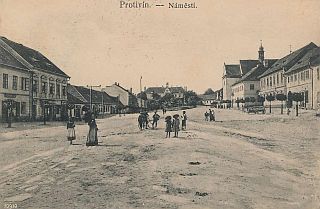
Pohled na náměstí směrem k zámku, 1908
Protivín náměstí is mentioned in the conversation between Švejk and the housemaid of Oberst Kraus in chapter [I.14]. It is revealed that she is the sister of butcher Pejchar on the town square.
Background
Protivín náměstí is the town square in Protivín, now called Masarykovo náměstí. It has a long shape and appears more like a broad avenue than a market square.
Quote(s) from the novel
[I.14.6] „Tak znáte v Protivíně na náměstí řezníka Pejchara?“ „Jakpak bych ho neznal.“ „To je můj bratr.“
 | Krč |  | ||||
| ||||||
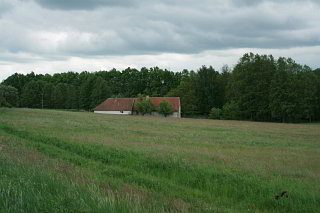
Krč no. 32, the birthplace of Kateřina Jarešová
Krč is mentioned in the same dialogue as Protivín. A certain Jareš was from Krč by Protivín according to Švejk.
Background
Krč is a village in the Písek district in South Bohemia, 3 km east of the centre of Protivín. In 1847 Kateřina Jarešová, the mother of Jaroslav Hašek, was born here. Her father, Antonín Jareš, was a pond warden nearby. These are circumstances that no doubt inspired the author.
Demography
According to the 1910 census Krč had 952 inhabitants of whom 951 (99 per cent) reported using Czech in their daily speech. The judicial district was okres Vodňany, administratively it reported to hejtmanství Písek. The village had its own Catholic parish, the nearest post office was located Protivín.
Source:Seznam míst v království Českém(1913)
Military
Per the recruitment districts, infantrymen from Krč were usually assigned to Infanterieregiment Nr. 11 (Pisek) or k.k. Landwehrinfanterieregiment Nr. 28 (Pisek).
Quote(s) from the novel
[I.14.6] „A kterýho Jareše, toho z Krče u Protivína, nebo z Ražic?“ „Z Ražic.“ „Ještě rozváží pivo?“ „Pořád.“
Literature
- Krč vesnice v srdci mém, ,2012
 | Sady Vrchlického |  | ||||
| ||||||
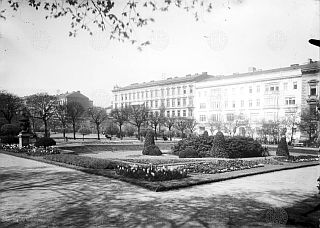
Městský sad, 26.10.1907

,11.3.1913
Sady Vrchlického is mentioned indirectly through the term "by the park". The circumstance arises when Blahník tricks Fox to follow him from Havlíčkovo náměstí, up along the park before turning down into Bredovská ulice. Already before this happened Švejk had turned up at the corner of the park and Havlíčkovo náměstí, subtly extracting information from the maid of Oberst Kraus about the dog's eating habits.
Background
Sady Vrchlického (Vrchlický Garden) (eller Vrchlického sady) is a park in front of the Prague railway station (in 1914 Nádraží císaře Františka Josefa), originally named Městský sad (City Garden). The park was laid out in connection with the construction of the railway station after 1870 and was at the time much larger than today. It even contained a fish pond, and a waterfall.
Between 1972 and 1977 a major redevelopment of the area took place: the new entrance hall for the railway station, a new transit road, and parking spaces. This reduced the area of the park considerably.
Renamed
On 10 March 1913 the Council of Aldermen in Prague decided to rename the park in honour of the recently deceased poet Vrchlický (1853-1912). The original proposal was aired in a meeting on 26 November 1912. Thus Sady Vrchlického was the official name of the park when Blahník and Švejk were sneaking around in the area.
Quote(s) from the novel
[I.14.6] „Každej den ve vosum hodin,“ šeptal civilista vojákovi, „chodí s ním služka na roh Havlíčkovýho náměstí k parku. Ale von je potvora, kouše o všechno pryč. Nedá se pohladit.“
[I.14.6] V osm hodin ráno druhého dne bylo vidět dobrého vojáka Švejka chodit na rohu Havlíčkova náměstí u parku. Čekal na služku se stájovým pinčem.
[I.14.6] „Šel jsem schválně kolem něho, drže zabalená vařená játra v papíru. Počal čenichat a vyskakovat na mne. Nedal jsem mu nic a šel dál. Pes za mnou. U parku jsem se otočil do Bredovské ulice a tam jsem mu dal první kousek.
Also written:Vrchlický GardenenVrchlický-GartendeVrchlický-hagenno
Literature
- Královská Praha, ,1912
- Wildenten, ,6.10.1929
 | Bredovská ulice |  | |||||
| |||||||
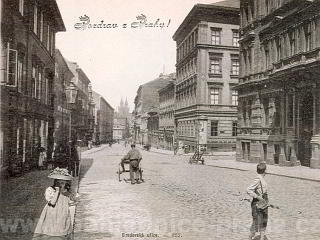
Bredovská ulice (now Ulice Politických vězňů) was a street were Fox followed Blahník just before he was put on a lead.
Background
Bredovská ulice is a street in Nové město. The current name Ulice Politických vězňů literally means "The Political Prisoners street".
Quote(s) from the novel
[I.14.6] „Šel jsem schválně kolem něho, drže zabalená vařená játra v papíru. Počal čenichat a vyskakovat na mne. Nedal jsem mu nic a šel dál. Pes za mnou. U parku jsem se otočil do Bredovské ulice a tam jsem mu dal první kousek
 | Jindřišská |  | ||||
| ||||||

7.4.1914. Pohled do Jindřišské ulice. Zprava domy čp. 939, 940, 941, 972 na Novém Městě. V pozadí vlevo zvonice kostela sv. Jindřicha.
Jindřišská is the street where Fox finally was put on a lead by Švejk and thus for a while became the property of Oberleutnant Lukáš.
Background
Jindřišská is a street in Nové město that is is perpendicular to Václavské náměstí. Many tram lines pass through it.
Quote(s) from the novel
[I.14.6] Zabočil jsem do Jindřišské, kde jsem mu dal novou porci. Pak jsem ho, když se nažral, uvázal na řetízek a táh jsem ho přes Václavské náměstí na Vinohrady, až do Vršovic.
 | Leipzig |  | |||
| |||||
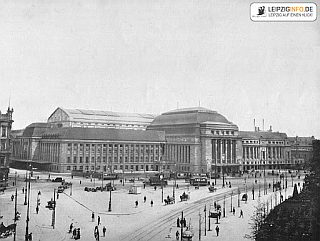
Hauptbahnhof
Leipzig is mentioned when the new family-tree of Fox is invented. According to this, Fox hailed from Hundezwinger von Bülow in Leipzig.
The Battle of Nations by Leipzig in 1813 is mentioned several times in [III.1], and it appears on Kadett Biegler's impressive list of battlefields. See also Liebertwolkwitz, Wachau and Lindenau.
Background
Leipzig is the second largest city in the state of Saxony, and was in 1914 part of the German Empire. The city is known for it's trade fair, university and as an important transport hub. The name is of Slav origin.
Quote(s) from the novel
[I.14.6] „To musí bejt tvou rukou napsaný. Napiš, že pochází z Lipska, z psince von Bülow. Otec Arnheim von Kahlsberg, matka Emma von Trautensdorf, po otci Siegfried von Busenthal.
[III.1] „Znáte dějiny bitvy národů u Lipska?“ otázal se, „když polní maršálek kníže Schwarzenberg šel na Liebertkovice 14. října roku 1813 a když 16. října byl zápas o Lindenau, boje generála Merweldta, a když rakouská vojska byla ve Wachavě a když 19. října padlo Lipsko?“
Also written:Lipskocz
Literature
 | Nuremberg |  | |||
| |||||
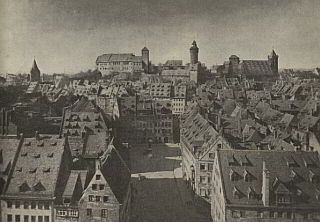
Světozor, , 17.10.1941
Nuremberg was the city where, according to Max's (former Fox) new pedigree, his mother (see Emma von Trautensdorf) was awarded a gold medal by the society of breeders of pure-bred dogs. See also Nürnberger Verein zur Zucht edler Hunde.
Background
Nuremberg is the second largest city of Bavaria and the largest in Franconia, in 1914 part of Germany. To judge by some short stories he wrote, Hašek visited the Nuremberg region in 1904.
Quote(s) from the novel
[I.14.6] Otec obdržel první cenu na berlínský výstavě stájových pinčů v roce 1912. Matka vyznamenána zlatou medalií norimberskýho spolku pro chov ušlechtilých psů. Jak myslíš, že je starej?“
Also written:Norimberkcz



|
I. In the rear |
 | |
14. Švejk as military servant to senior lieutenant Lukáš | |||
| © 2008 - 2024 Jomar Hønsi | Last updated: 20.11.2024 |


